
Q.T.E.V.
Queen of
Please Note: Firefox and some other Search Engines may not be suitable
Use Google Chrome for this Web Page to load perfectly!
Please
Note: All ssMaritime and other related maritime sites are
100% non-commercial and privately owned, thus ssmaritime is NOT
associated with any shipping company or any other organisation!
Although the author has worked and has been involved in the
passenger shipping industry for well over 60 years, but due to
his old age and poor health, he was forced to retire. Yet, he has
completed well over 1,435 Classic Liners, Passenger-Cargo Liners
as well as humble converted C3 converted Migrant Liners, which
has transported countless thousands of folk to the new world, as
well on vacations’. I trust the features online will
continue to provide Classic Liner and Ship enthusiasts both the
information they are seeking, but more so provide a great deal of
pleasure and relive many happy memories!
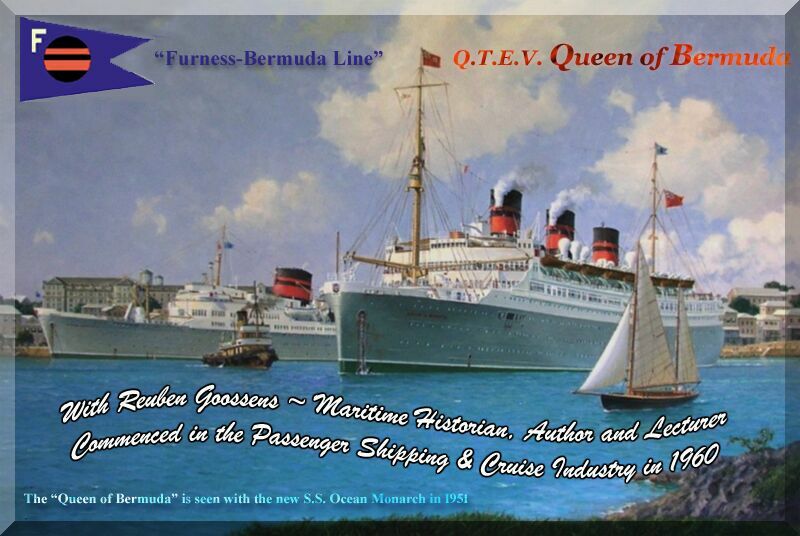
Thank you Shaun McGrath
for this brilliant painting, but it is sad that you were not able
to provide who actually created it,
Please Note:
Postcards, photographs & other images are either from the
author’s private collection or from supporters.
Thus thank you to a
number of very special ssmaritime supporters for sending me their
wonderful
I am sorry but some of the images shown may not be of the greatest quality, but they were the best that were available.
********************
There are two parts to this feature, Part One
takes care of the Companies beginnings and some of their earlier
ships, and then Part Two cover’s the Q.T.E.V. Queen of
The Q.T.E.V. Queen of Bermuda was considered by many to be one of the most graceful class of passenger ships ever built, and she served the “Furness Bermuda Line” for over a quarter of a century and in doing so was one of the first ships to offer a luxury cruise, and became known as the “Millionaire’s Ship”.
PS: Q.T.E.V. means “Quadruple Turbo Electric Vessel”.
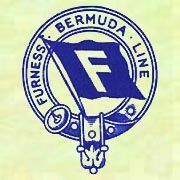
The ‘Furness
In 1919 “Furness, Withy and Co” was
awarded the mail contract for the
The company had been renamed the “Quebec Steamship Company” in 1880 and then in 1913, they were taken over by the “Canada Steamship Lines” but continued to trade in its original name.
The Furness Bermuda Line, as it became, operated for 47 years until 23 November 1966 when the Queen of Bermuda, the last of the sister ships, left for the final time.
The “Furness Bermuda Line” started
service with the “Quebec Steamship Co” ship, the S.S.
Bermudian that had been built in 1904, but she was renamed “
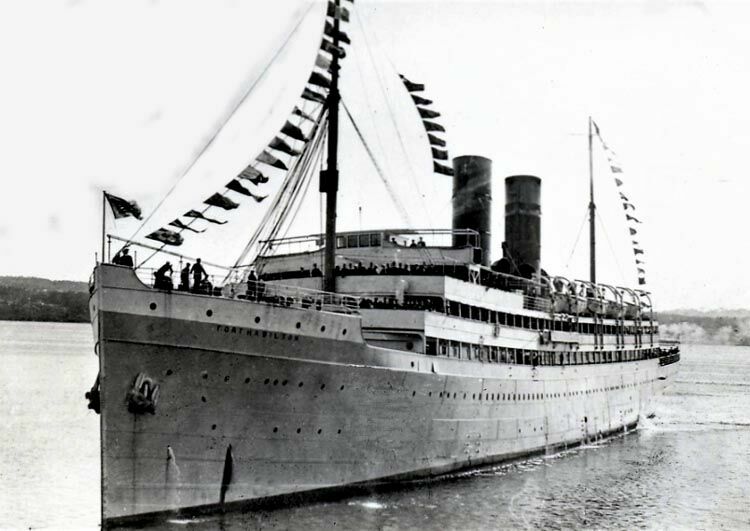
The S.S. Bermudian
is seen after she was renamed the “
Soon thereafter, the company added their first
pair of sister ships, the “
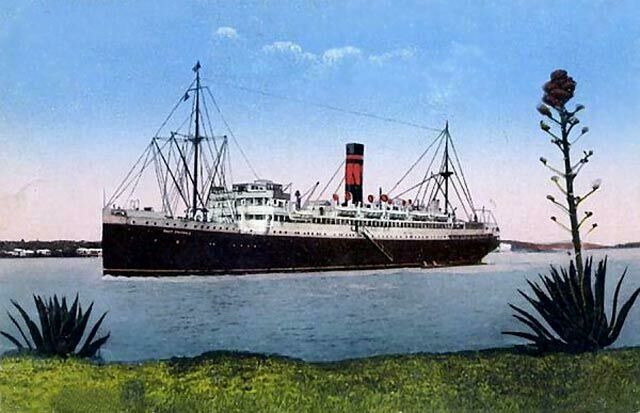
The S.S.
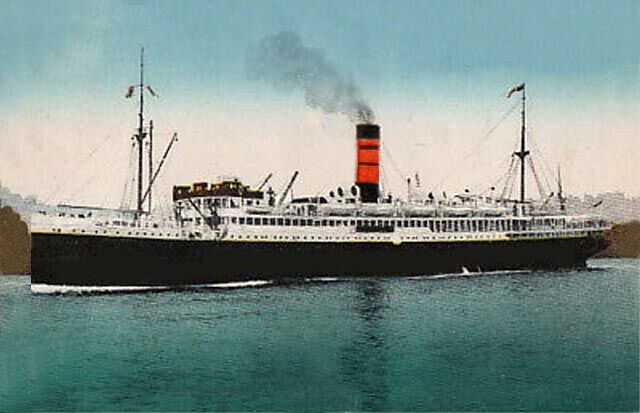
Shortly thereafter ‘Furness’ formed
the ‘Bermuda Development Company Ltd’, acquiring 645
acres of land at
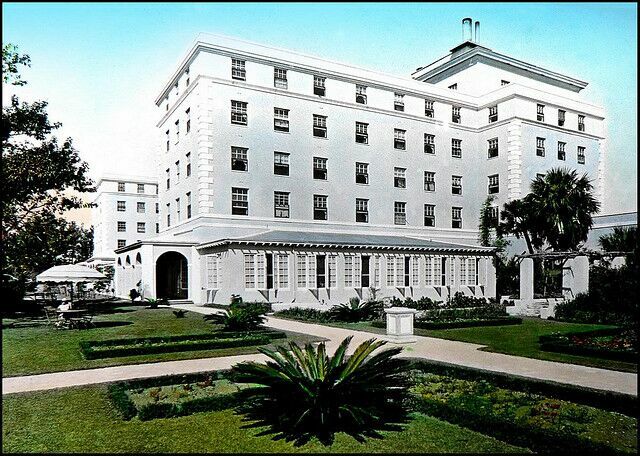
The luxurious “Hotel Bermudiana”
‘Furness, Withy and Company’ invested a great deal in the tourist and holiday trade in Bermuda and, during these years of hotel development, ordered a new ship with the largest dimensions that could enter the Hamilton Harbour at the time.
‘Harland & Wolff’ in
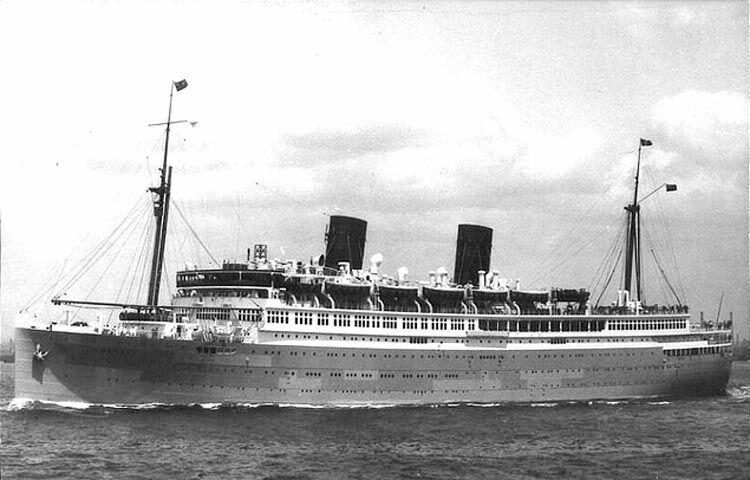
Above &
below: The M.S. Bermuda and her magnificent two level
Main Lounge
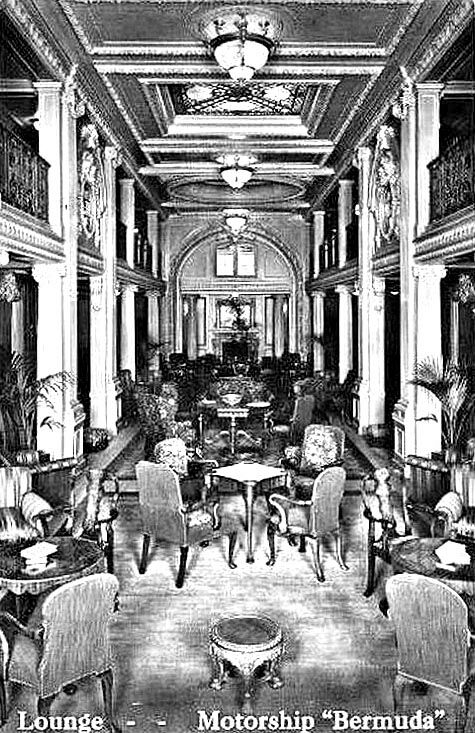
She was 547 ft long and had a beam of 74 ft,
and had a service speed of 17 knots. An order was also placed
with ‘Blythswood Shipbuilding Company’ for another
larger tender, being the 730 GRT ‘Mid Ocean’ which was
completed in 1929 and renamed ‘
However, on a fateful voyage the “Fort
Victoria” departed New York on December 18, 1929, with 206
passengers, when at 4:00 pm whilst stationary dropping off the
pilot, at the entrance to the Ambrose Channel during heavy fog,
suddenly out of the thick fog, the ‘Clyde Mallory Line’
liner, the S.S. Algonquin” sliced right into her on her port
side. Thankfully, all of her passengers and crew were safely
evacuated, but by 7:30 pm the ‘
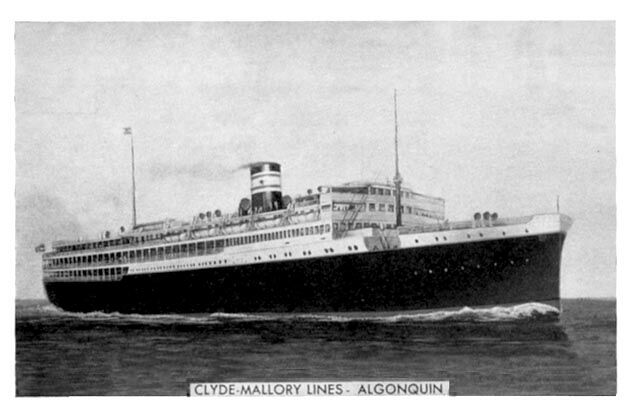
Following the tragic loss, ‘Furness’ secured the charter of the luxurious “Holland America Line” liner the S.S. Veendam.
Then within three months, the company placed an
order for a new ship. The contract was signed on March 30, 1930
with ‘Vickers-Armstrong’ at

The Q.T.E.V.
Monarch of Bermuda is seen departing
But then suddenly there was more huge
misfortune for the ‘Furness Bermuda Line’. Tragically,
early in the morning of Wednesday June 17, 1931, a disastrous
fire broke out onboard the “Bermuda” while at the dock
in
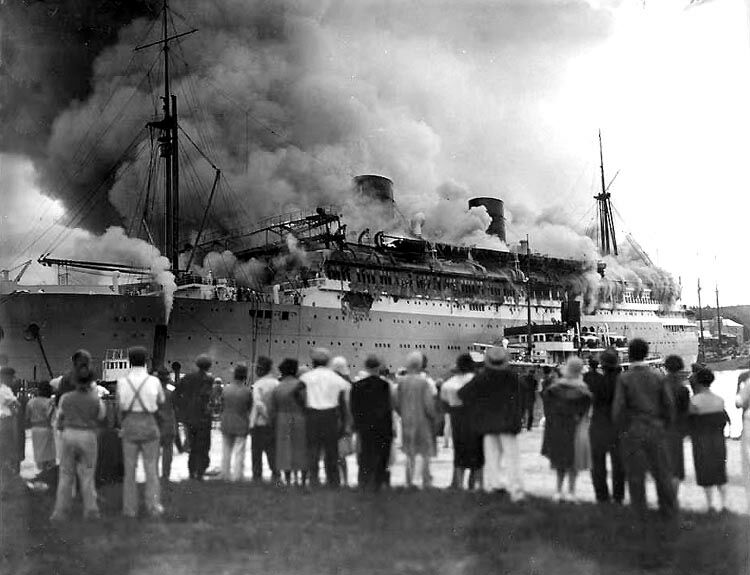
The M.S. Bermuda is
seen on fire on June 17 & 18, 1931, whist berthed at
With boats attending to fire hoses, as well as fire-men from ashore
Arriving back at the ship around 12:30am, the captain saw her to her cabin B-139 and then went to his quarters on the bridge. Mrs. Dixon was awakened by the smell of smoke and, upon opening her door, the cabin started to fill with heavy smoke. She closed the door and climbed up on the washstand, which was under the porthole, clambered out, and dropped 35 feet into the water before swimming to the ferry terminal near the bow of the ship. There was just one sad fatality that morning, the assistant barber Mr. Helme, who was believed to have been sleeping on a sofa in the Barber Shop.
The “
Following an inspection of the extensive
damage, ‘Furness’ decided that the liner could be
repaired, and arrangements were soon finalised for her to return
to her builder’s yard in
Back in Belfast, repairs to the
“Bermuda” had been proceeding quickly, but suddenly the
news came on November 19, whilst the new Monarch of Bermuda was
on her maiden voyage from UK to New York, that the M.S. Bermuda
had again caught on fire and this time the fire raged throughout
the night and it caused far more damage it was so extensive than
the earlier fire in June, that this time her entire interior was
completely gutted. During the morning of November 20, 1931, she
was flooded and allowed to settle on the bottom, as this time the
“
The wreck was sold to ship-breakers but, but as it is said; “Things happens in three’s”, for whilst she was under tow from Belfast to Rosyth to be broken up, her tow line snapped during heavy weather and she ended up being blown ashore on the Scottish coast. The wreck was left and she was smashed to pieces by those massive waves. Over time the once beautiful M.S. Bermuda gradually rusted away.
Within days of the “
********************
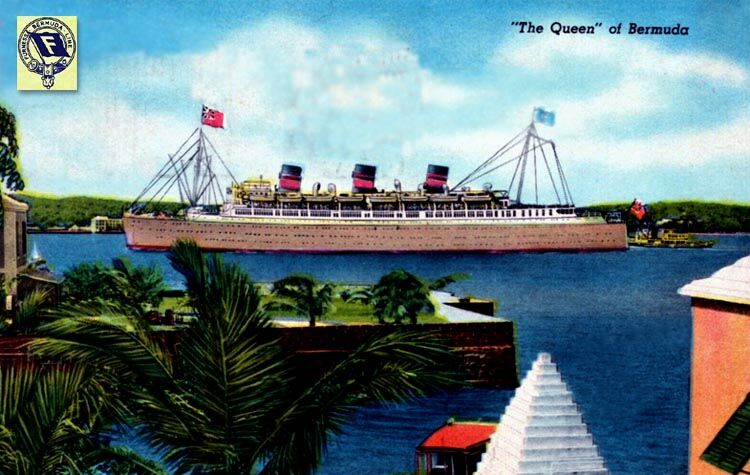
A superb mage of
the great liner Q.T.E.V. Queen of Bermuda arriving at
Like her sister, the “Queen of
‘Furness, Withy’ ordered their new ship the “Queen of Bermuda” early in 1932 as they needed to replace their 19,086 GRT (Gross Registered Ton) M.S. Bermuda, which had tragically been destroyed by a number of fires. First in June 1931, and even after raising her and whilst restoring her, she again caught fire that completely destroyed her in November that year at the shipyard in June. Sadly, she had only served for three and a half years.
The “Queen” was constructed by
‘Vickers Armstrong Ltd’, at
At the launching Sir Herbert Lawrence, Chairman of Vickers Armstrong, Ltd, stated that; “She had been the fastest ship ever built in British shipbuilding history, yet she was built to perfection in every detail!”
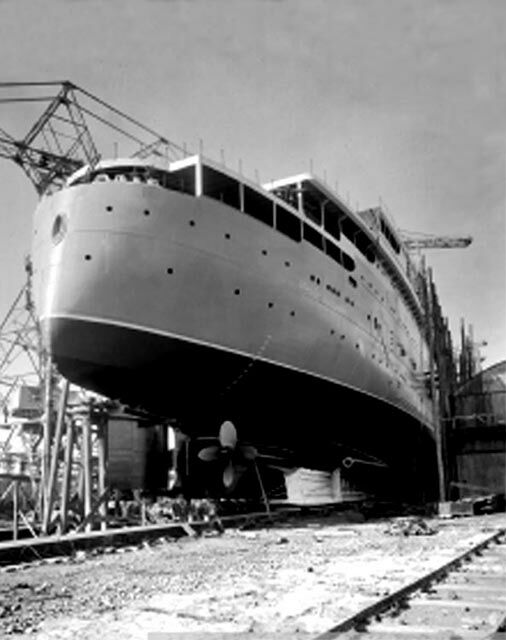
Here we see her just a day prior to her launch day
She was ready to be launched on September 1, 1932, and officiating was Lady Cubbitt, who was the wife of the Governor of Bermuda. She named and launched the ship with very costly bottle of ‘Empire Wine’ as soon as the bottle hit her bow, the “Queen of Bermuda slowly slid down the slipway into the river.
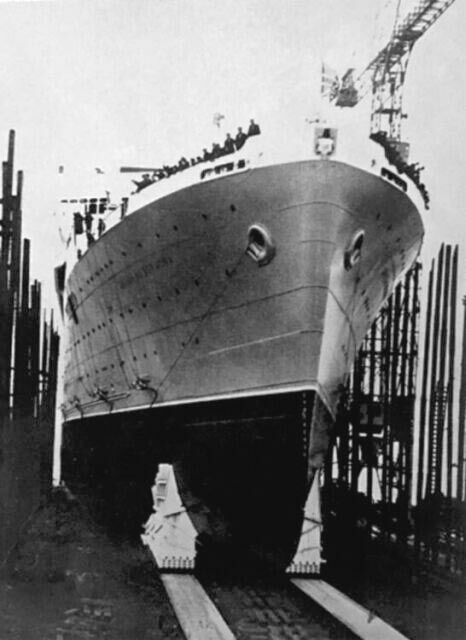
Above &
below: The “Queen of Bermuda” head down the slipway
and enters the water for the very first time
Watch a short video
of her launching; https://www.youtube.com/watch?v=jUeZE2SKsW8
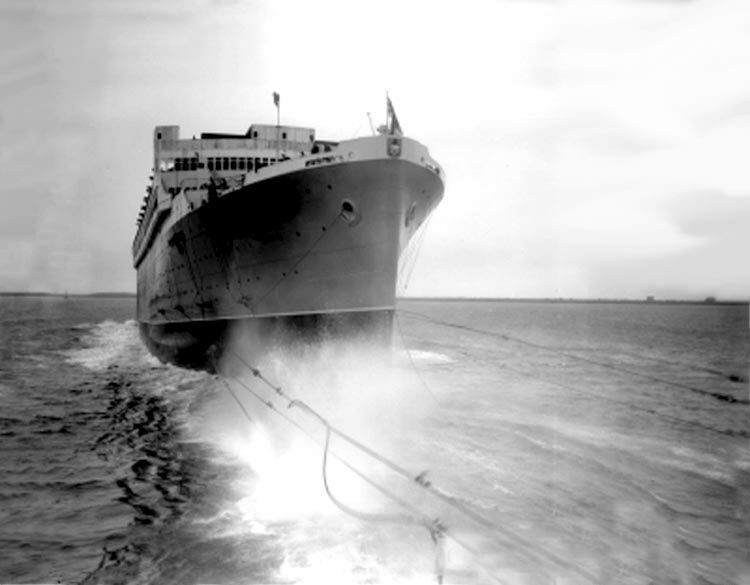
Tugs soon took her in tow and took her to the Vickers yard and her fit-out berth where she would be completed
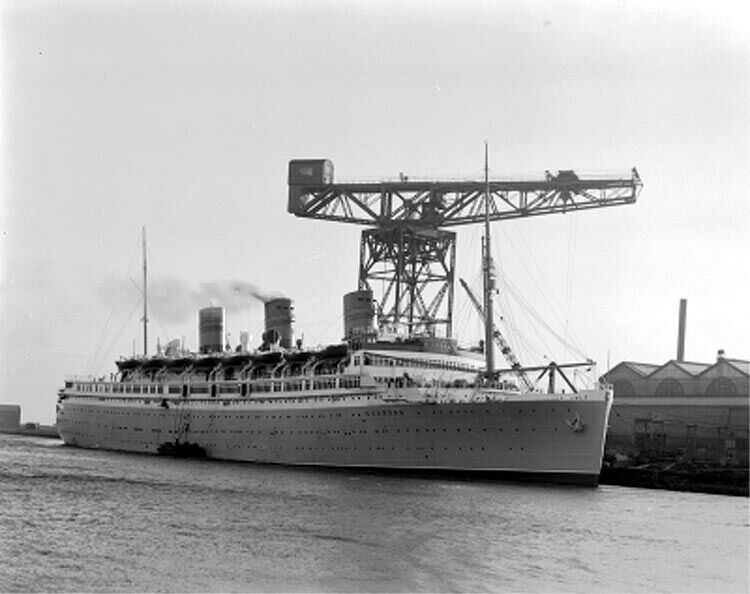
The “Queen of Bermuda” is seen at her Fit-out berth and is close to completion
The “Queen of Bermuda” having
been completed, left the builders basin at
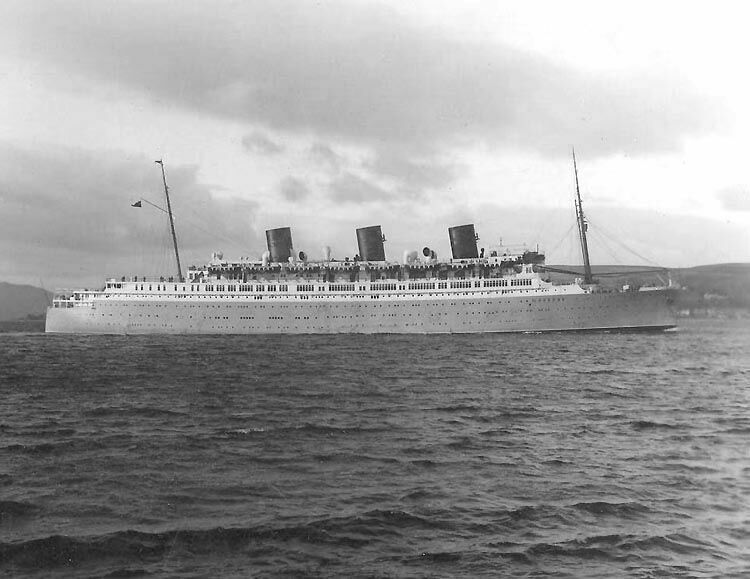
She is seen her
heading out of the
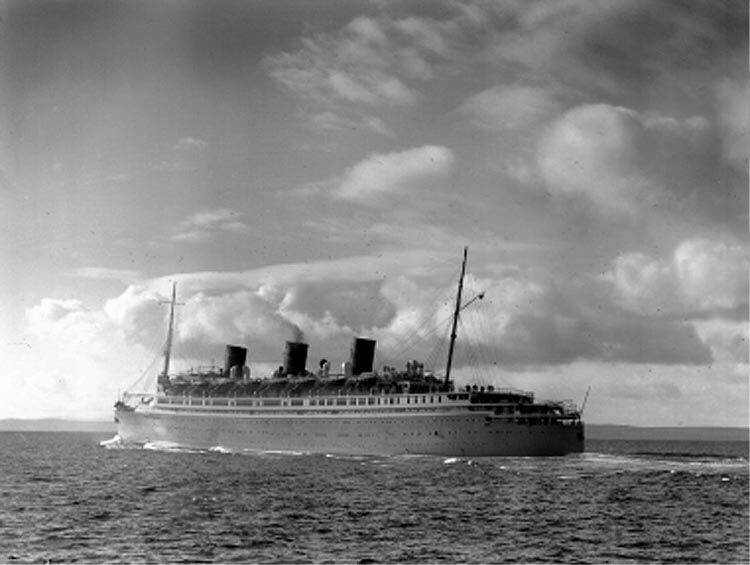
Here we see the “Queen” during undergoing her ‘speed trail’
She was delivered to her owners on February 14,
1933.The 553.47 ft - 168.7 m long ship, offering luxury
accommodations for just 700 First Class guests and just 31
passengers in an excellent Second Class. It was no wonder that
the Q.T.E.V. Queen of
She and her sister the “Monarch of Bermuda” was constructed to such a high standard for hose days, with magnificent Public venues and a large Deck spaces and private facilities in all Staterooms. Although the “Queen of Bermuda” may well have been more of a luxury cruise ship, but had all the attributes of a genuine luxury Atlantic Ocean Liner, in profile with her three proud funnels, her two tall masts, thus she could easily be mistaken for the “Queen Mary”, even though she was much smaller at just 22,575 GRT.
The hull is of handsome external appearance, with its lofty white superstructure characteristic of the modem passenger liner. The cruiser stern, three black funnels with bands of deep red, two well-raked masts, the topsides with a green band at the water-line, a narrow white band above, and the remainder finished in French grey, give the vessel a striking appearance. As in the Monarch of Bermuda, electricity is used on the most extensive scale possible throughout the entire ship. It is used for the propulsion and steering of the vessel, for the lighting and ventilation of all the public rooms and cabins, for the refrigeration and cooking of food, for the handling of cargo, for the signalling and indicating devices and for the driving of the laundry machinery, gymnasium equipment and printing presses. The electrical equipment required for these purposes involved the manufacture of turbo-alternators, propulsion motors and control switchgear, auxiliary generating plant, and over 270 marine-type electric motors for auxiliary machinery totalling approximately 3,000 horse-power in capacity.
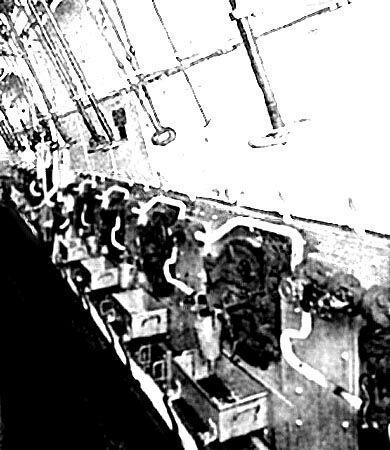
The Electric Propulsion Unit
The power for the electric propulsion of the “Queen of Bermuda” was supplied by steam from eight water tube boilers arranged in groups of four in the boiler-rooms having a combined heating surface of 39,720 square feet - 3,690 m2. The boilers supplied steam at 400 lbf/in2 to two steam turbines. The boilers burn oil and the steam generated drives turbines which are coupled to the electric generators. The turbines drove electric generators that powered electric motors to drive her Quadruple (four) propellers giving her a speed up to a maximum of 21.07 knots.
On February 21, 1933 was the day she would depart Liverpool and head for her American Home port New York, for she would be based there and operate her highly specialised New York to Hamilton, Bermuda, voyages being only a 40 hour voyage there and back and whilst at Hamilton, she would remain there for four full days and then return.
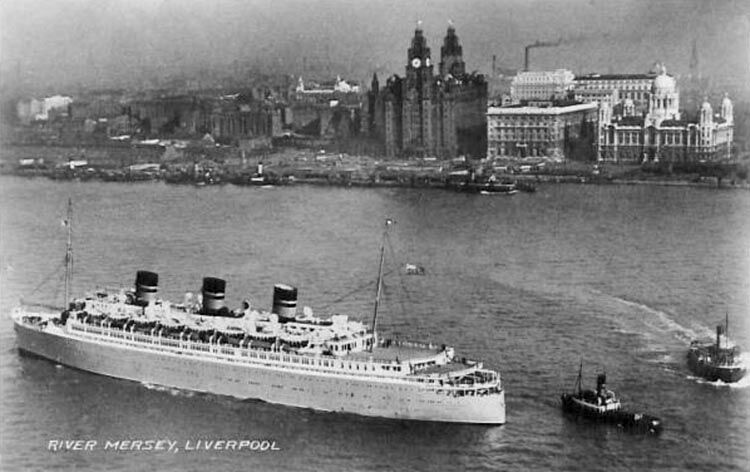
Q.T.E.V. Queen of
Bermuda departs Liverpool on her Inaugural voyage bound for
PS: Captain Musson always said that “Q.T.E.V.” really meant “Quick Turnaround Every Voyage”
This would be one of not too many Atlantic peacetime Atlantic voyages she would operate with passengers on board, but for her guests they were certainly travelling in style!
Upon arrival in
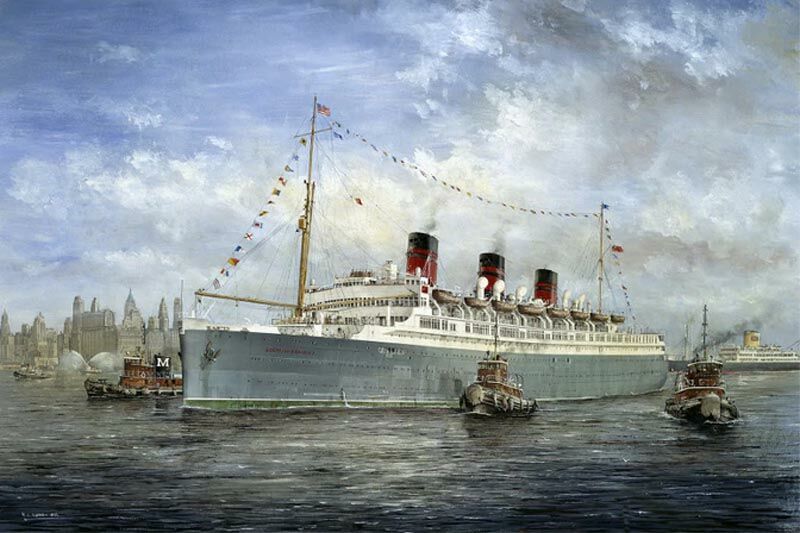
She headed for her berth with the aid of her allotted tugs
This painting is by a great marine artist a Robert G. Lloyd
It soon became known that the “Queen” had one of the most amazing ‘steam horn’, for it had a most beautiful and a powerful Six-Chime sound, being deep and a melodic resonating sound that could be heard from a great distance, announcing all her departures.
Her local agency had been promoting their new ship with a fine new brochure which revealed many of her magnificent public venues and her excellent Staterooms and the Huge multi room De-Luxe Suites.
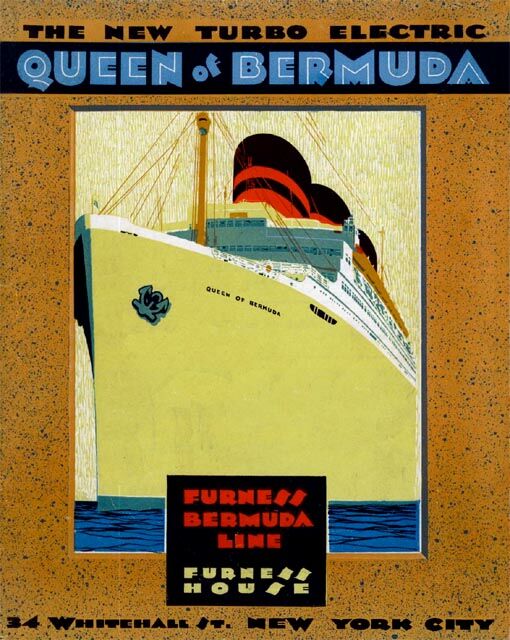
An early release Brochure
Then arrived the big day for the Q.T.E.V. Queen
of Bermuda, for she was about to join her sister the
“Monarch of Bermuda” for on March 7, 1933 she
was about to depart on actual her maiden voyage from New
York and head on her 40 hour voyage to
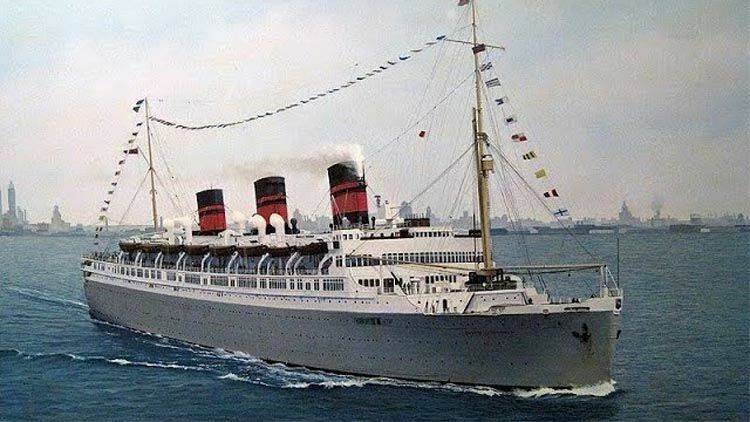
The
“Queen” departs
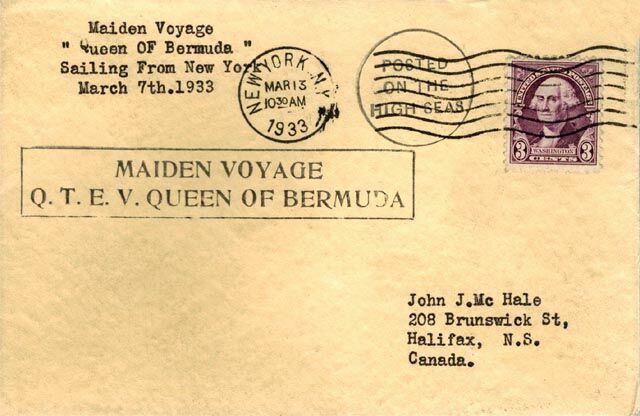
A special Maiden
Voyage cover envelope sent during her outward voyage to a John Mc
Hale
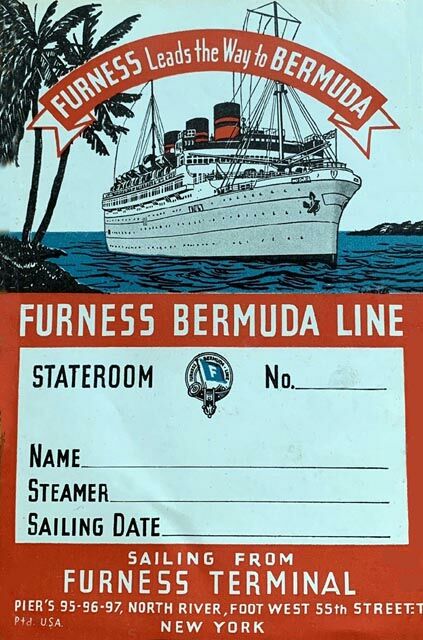
A “Furness Bermuda Line” luggage label
Sadly her maiden voyage was not one of the typical sunny balmy voyages previous passengers were used to, in fact this voyage they experienced the complete opposite, stormy weather, which saw her arrive three hours late at Hamilton on March 9, which is very rare indeed! “The New York Times” reported the next day;
“
During another voyage the “Queen of Bermuda” set a brand new record on the New York to Bermuda run, for she sailed from Sandy Hook, New York, to David’s Head, Bermuda, in just 32 hours 48 minutes, at an average speed of 20.33 knots, meaning she beat her sister ship, the “Monarch of Bermuda” by half a knot, which was the previous record held by her.
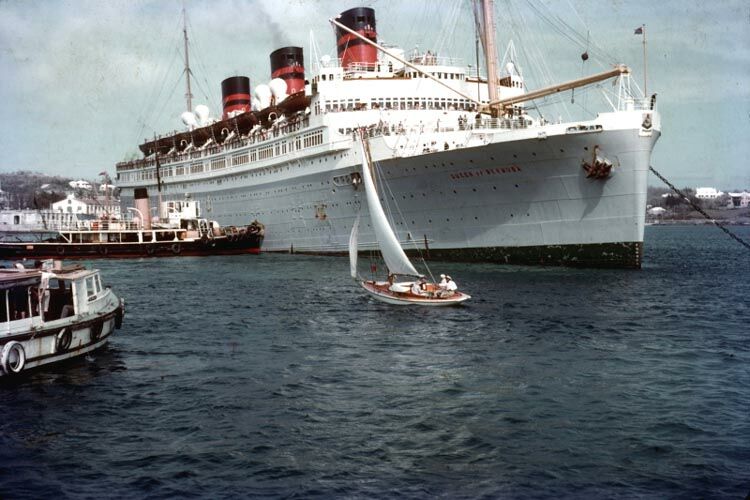
“Queen of
Bermuda is seen at
The next six years went well and both ships
gained more and more popularity, for not only were these ships
greatly loved, but they offered the complete package, as the
‘Furness
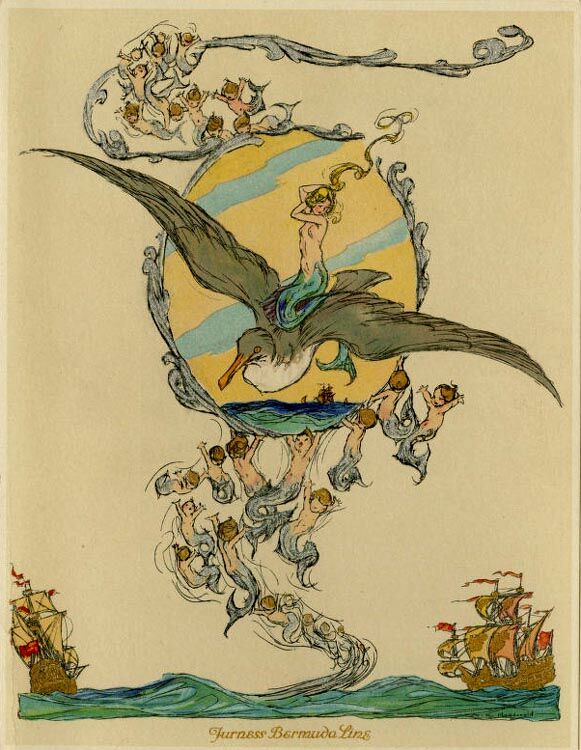
Above &
Below: Lunch Menu on January 4, 1934 including notice of a
Movie at 2.30 pm in the Lounge
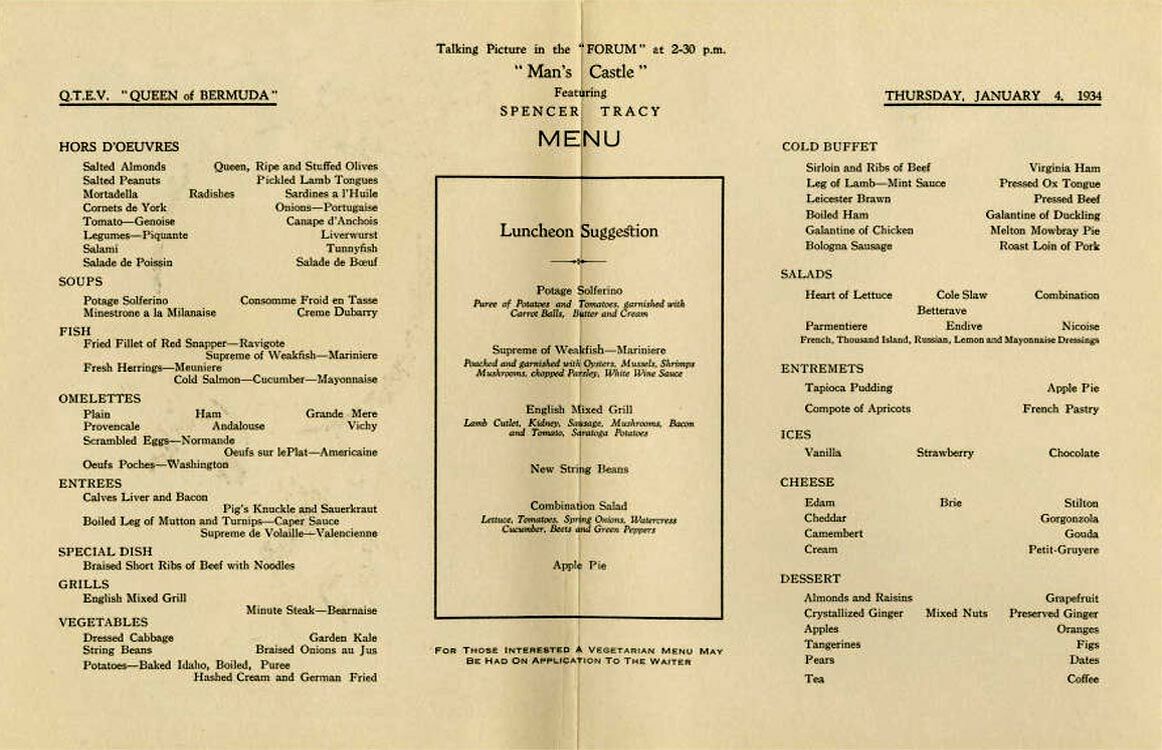
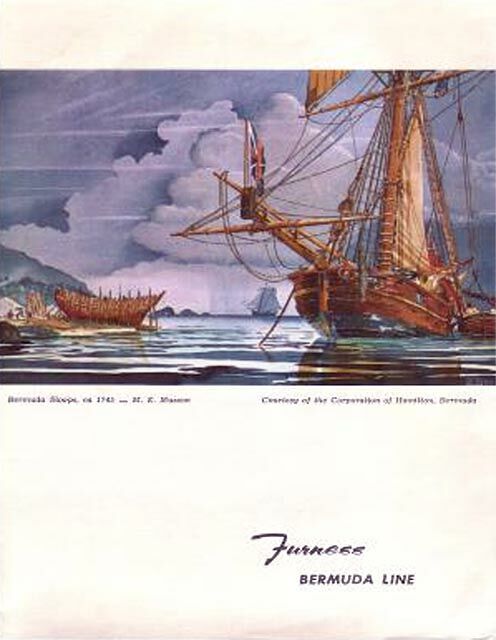 -
-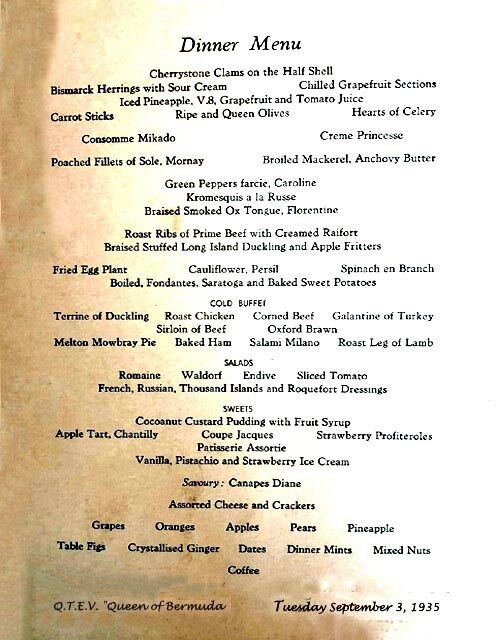
A Dinner Menu Tuesday September 3, 1935
I am sorry that the
menu page was rather aged, but I did try to clean it as much as
possible

Above &
below: Purser Dalziel had invited several Guests to a private
Luncheon and this was their Menu
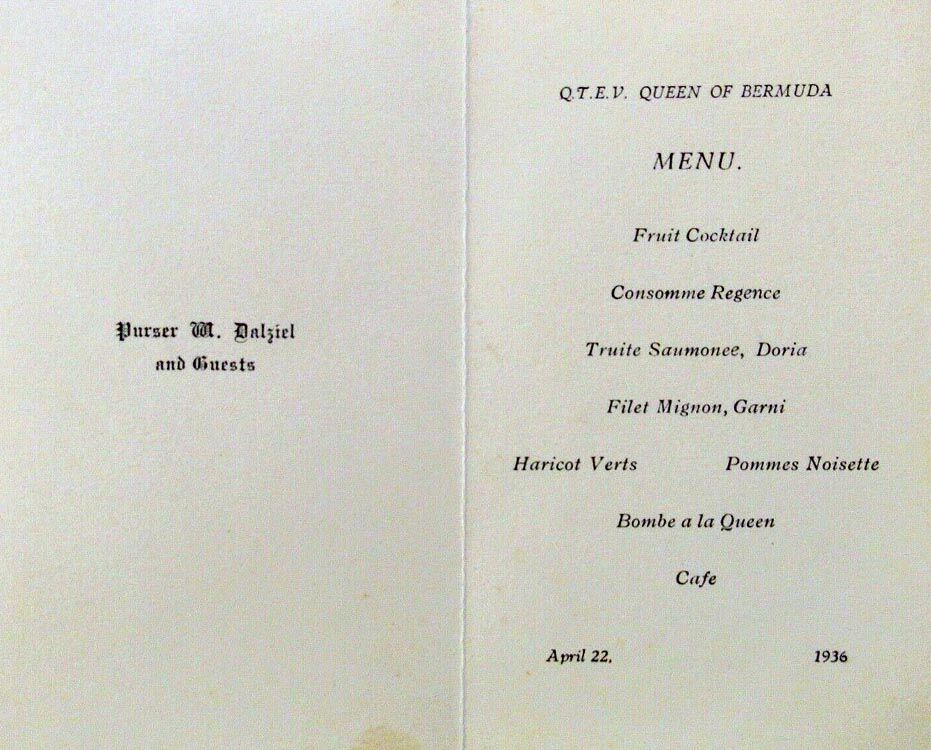
Entertainment was always made special and it was certainly the very best available! Thus it was no wonder that passengers would return again and again! Many of the famous and the very rich, such as the Vanderbilts and the Rockefellers would sail on her, including countless movie stars, opera greats and singers, from crooners, country and western singers to Rock & Roll starts. Just some of the stars that sailed were; Clark Gable, T.S. Eliot, Gertrude Lawrence as well as child film star Shirley Temple and great authors like Hemmingway and Noel Coward.
The truth is that Americans loved the
“Queen of Bermuda” so much, they even chose her to
feature in the biggest photograph ever created, the 60 ft long
and 18 ft high, and it was displayed on the concourse of
********************
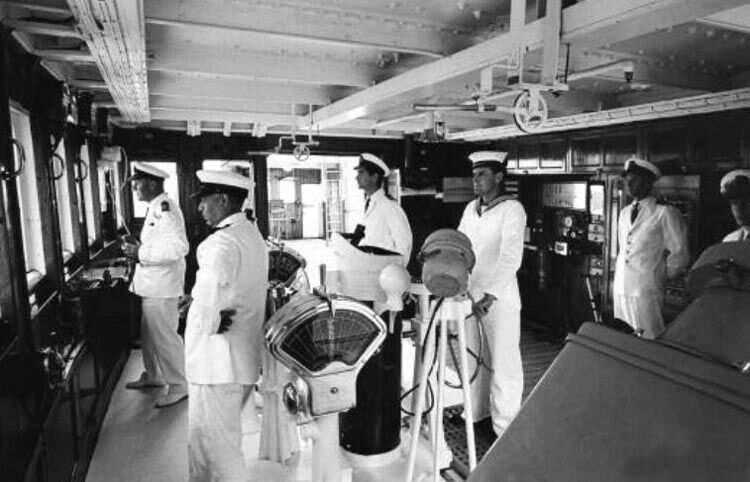
Here we see Captain on the Bridge (nearest to the camera looking forward with his hand at his side)
as well as other officers and the helmsman at the wheel
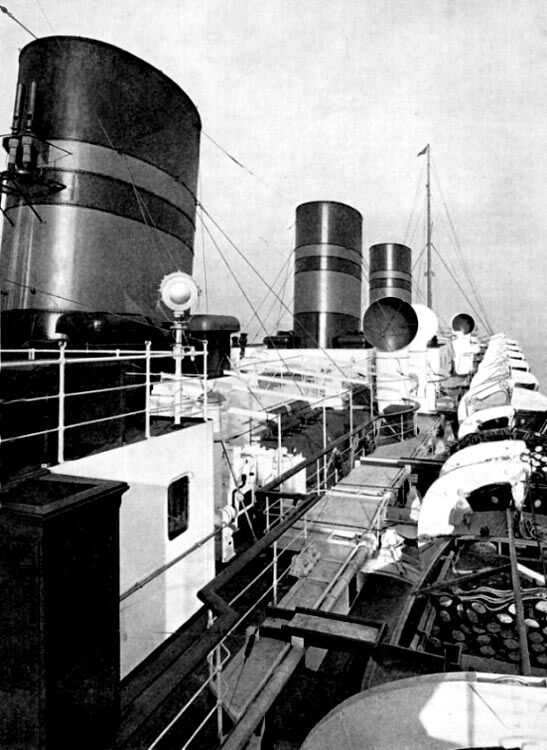
Looking aft from the portside Bridge wing and we see her three magnificent three funnels
The interiors of the “Queen of
Bermuda” were quite remarkable as she was designed in a
variety of contemporary and period styles. Most of her Lounges
and Bars had lavish lighting and detailing, that later became
known as ‘Art Deco’, but at the time it was simply
referred to as “modern as
Far forward was a narrow hallway come lobby, from port to starboard with a single Elevator (lift) and a timber Stairway that commenced on the portside and wrapped around the lift down to A Deck. Of course there were doors on both sides of this hallway that led out onto the Sun Deck. There were also two narrow hallway’s that led aft to the Lounge’s upper Galleries that featured decorative metal work, and had luxurious seating and small mahogany drinks-tables. This area over-looked the huge Main Lounge below on Promenade (A) Deck. Whilst directly behind the galleries there was a windowed wall, and behind them there were the popular ‘Sun Deck Verandas’ popular location for afternoon tea or coffee.
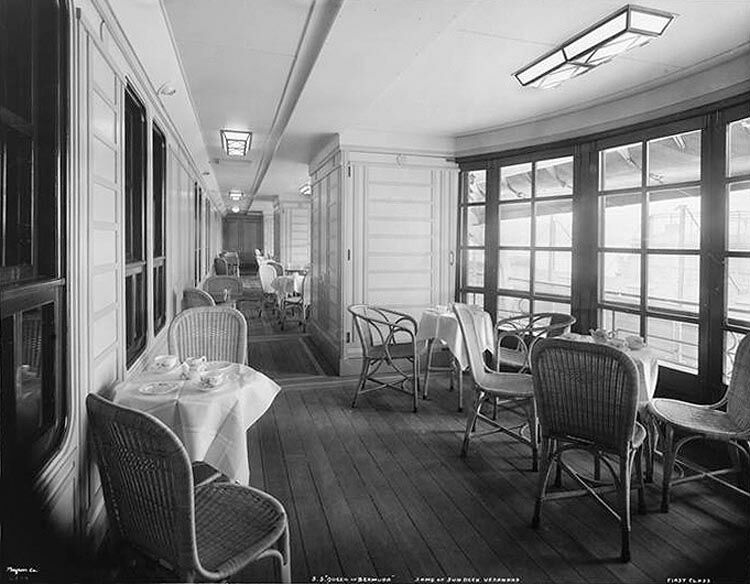
The Sun Deck Verandas
Aft of the Lounge Gallery area, amidships was the large Central Main Lobby and its magnificent fine timber Stairwell and the two large Elevators (Lifts) one on each side of the deck. This Lobby and lifts commenced down on E Deck and went up a total of 6 decks to Sun Deck. In the centre of the Lobby here was an opening with a beautiful decorative balustrade with a view three decks below to the “Main Entrance Hall” on C Deck.
De-Luxe Staterooms:
Then just aft along a central hallway there were ten beautiful De-Luxe two bed Staterooms all with private facilities, but then of course every single Stateroom on board regardless of Class had private facilities, with either a bath or a shower!
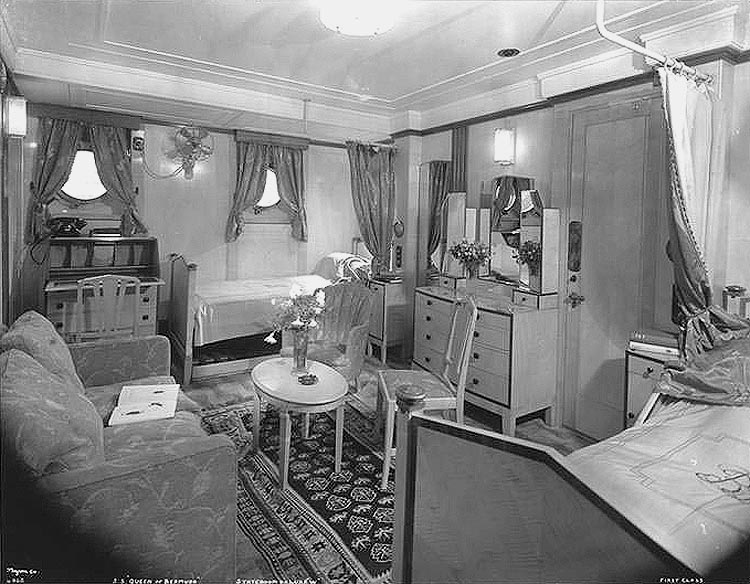
One of the ten De-Luxe Twin Bedded Staterooms on Sun Deck
At the end of the central hallway there was a smaller lobby which led into another main venue being the magnificent and elegant Smoking Room.
The Smoking Room:
The “Corona” Smoking Room was very much a traditional British style venue, being panelled in English oak, and it had large bay windows and it featured fine heavy mahogany timber Tudor and Jacobean furnishings with either velvet or leather upholstery; genuine Persian rugs were scattered around the floor in several places, and the venue had a large Fire Place on the forward wall. Above there was a dome that reached up high onto Bridge Deck featuring sets of three windows long the sides allowing light to enter during the day and viewing the stars at night
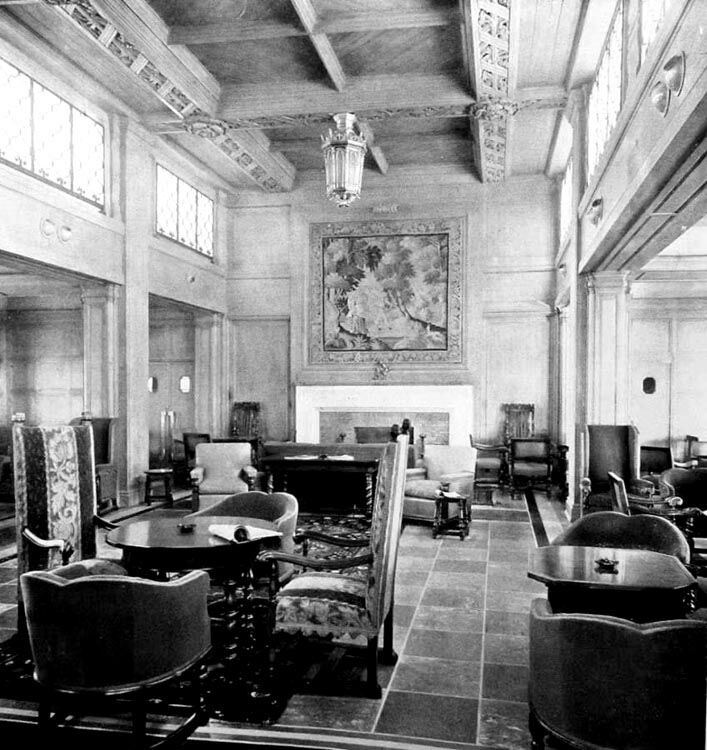
Above &
below: Two view of the Smoking Room
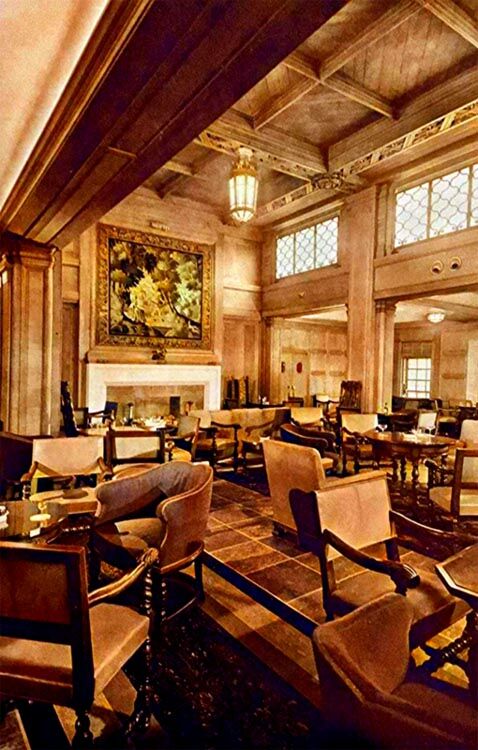
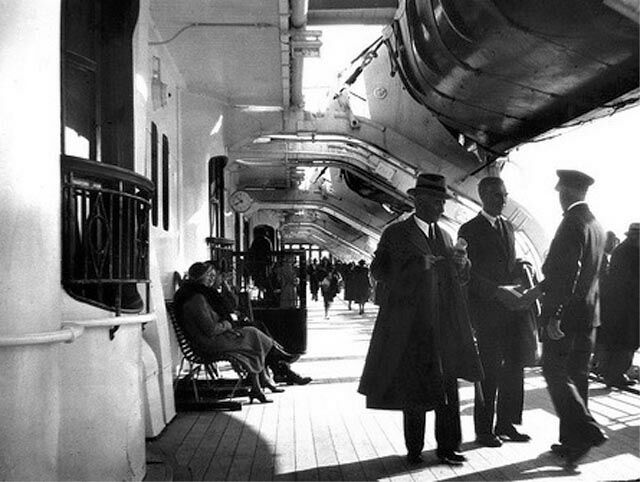
Passengers seen
relaxing and having a chat on Sun Deck
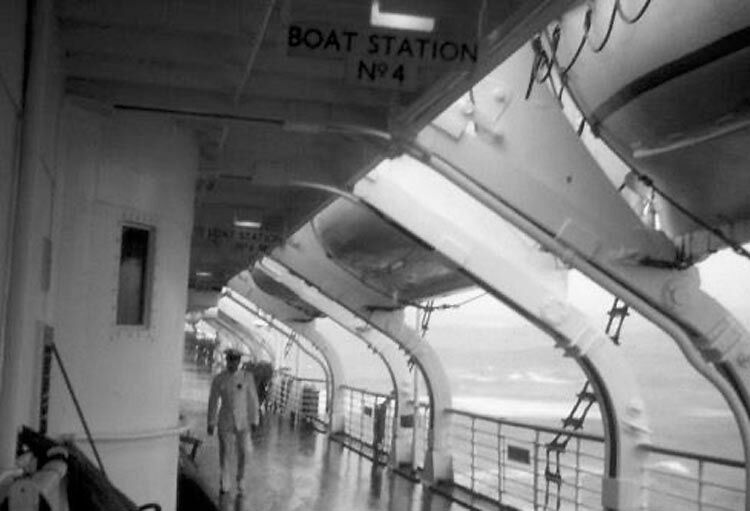
Sun Deck seen on a
rainy day
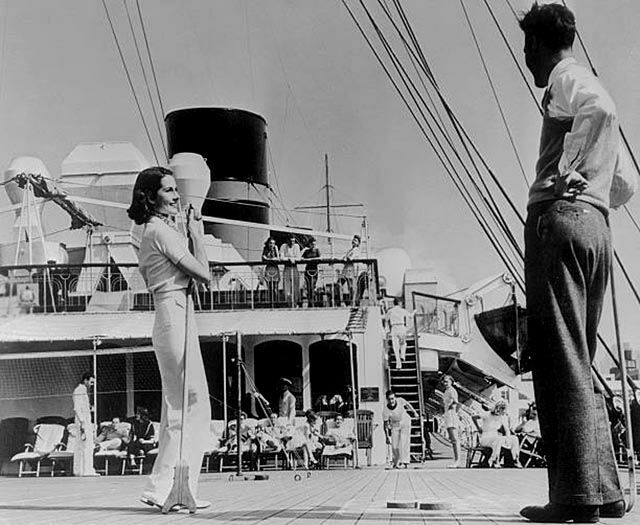
Sun Deck aft was
the main Sports Area
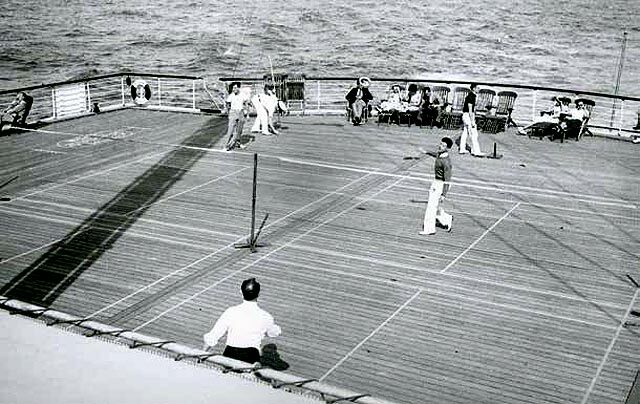
Passengers playing deck quoits which is a great game!
The Library:
The “Homer” Library was located far forward on this deck, enjoyed fine views overlooking the bow. The venue was styled in the glamorous Empire style, panelled in the exotic African ‘Bubinga’ timber.
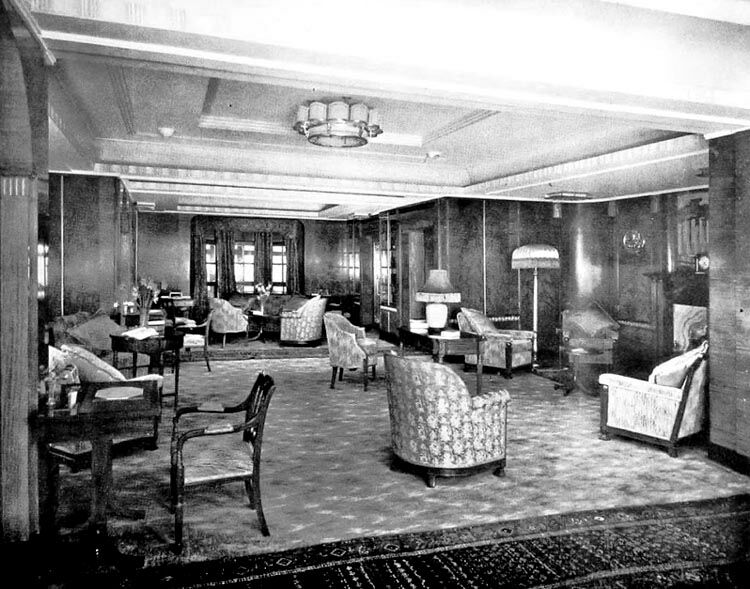
The Library
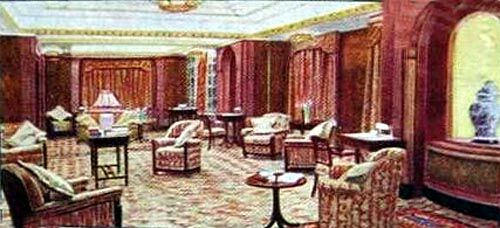
A small colour version of the Library, giving us a better idea of the beauty of this fine venue!
The Main Lounge:
The magnificent “Forum” Lounge was over 20 feet high and it featured a decorative upper level gallery up on Sun Deck as described earlier. This venue was had a hidden box that was fitted for Cinema projection and was capable for full scale Theatrical Productions having a spacious Stage. This fine venue was panelled in Golden Sycamore, and its column’s capitals were finished with silver leaf. The furnishings covered beautifully upholstered large sofas, and matching lounge chairs, as well as velvet club chairs with tables being mostly single posted in mahogany. At the wall with the fireplace at the side stood two tall silver light towers and a huge mural featured on the wall above. High above in the dome was a huge glass decorative ceiling light system.
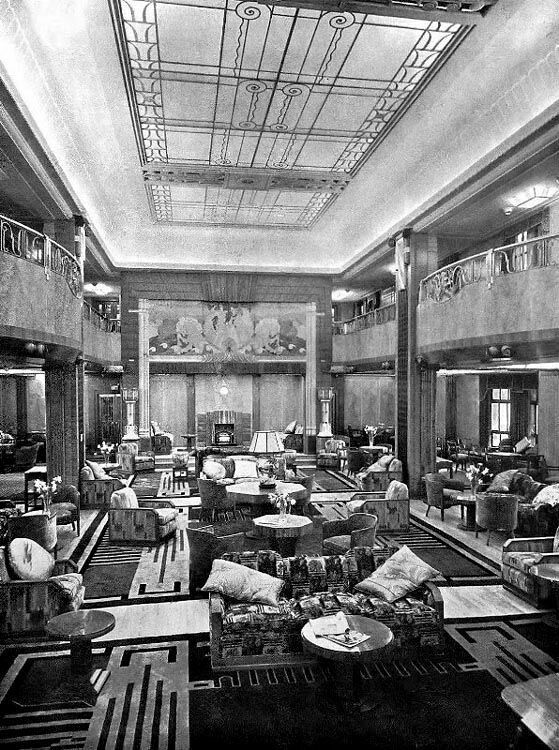
The elegant Main Lounge and above we also see the Gallery’s up on Sun Deck
as well as the huge glass and wrought iron featured light fitting
Directly aft was the Ships Central Lobby with its Stairwell and lifts, which led into the of two Cafés, the first was named the “Siris Café” and it was located forward of the “Elysium Dancing Hall”, whilst the second was the “Isis Veranda Café”.
Siris Café:
I only have an artist impression of this café, but it will give us an idea of what it would have looked like. Both of these Café’s had their own bar to satisfy the desires of the American clientele who were of course living under Prohibition. The Bar was located in the center of the forward wall
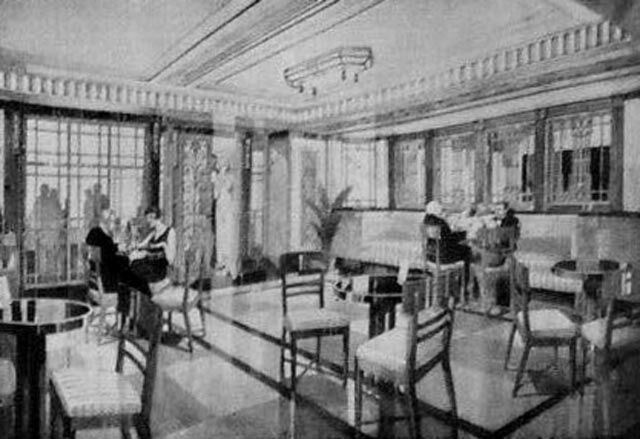
Here we see the forward “Siris Café”
The Elysium Dancing Hall:
The “Elysium Dancing Hall” spanned the full width of the ship, and it featured an island bandstand on the port side. The surrounding full-height glass panelled windows could be removed in order to allow in balmy tropical breezes, whenever it was needed. This venue was considered to be “Party Central”.
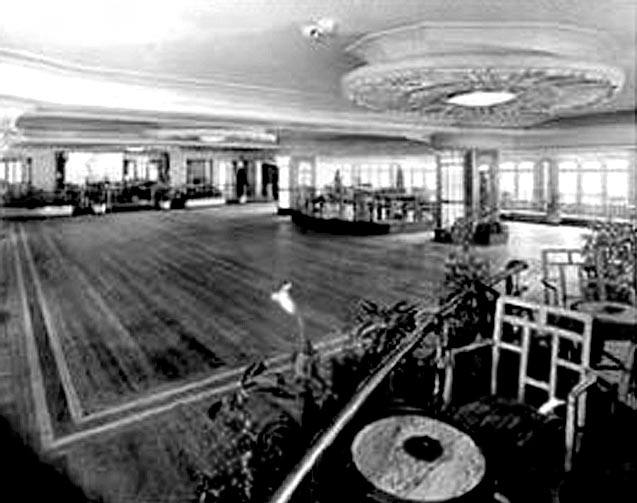
The popular
“Elysium Dancing Hall”
As I stated earlier, there were two Verandah
Cafés, the forward of the Dancing Hall was named the “Siris”
and he one directly aft was the “
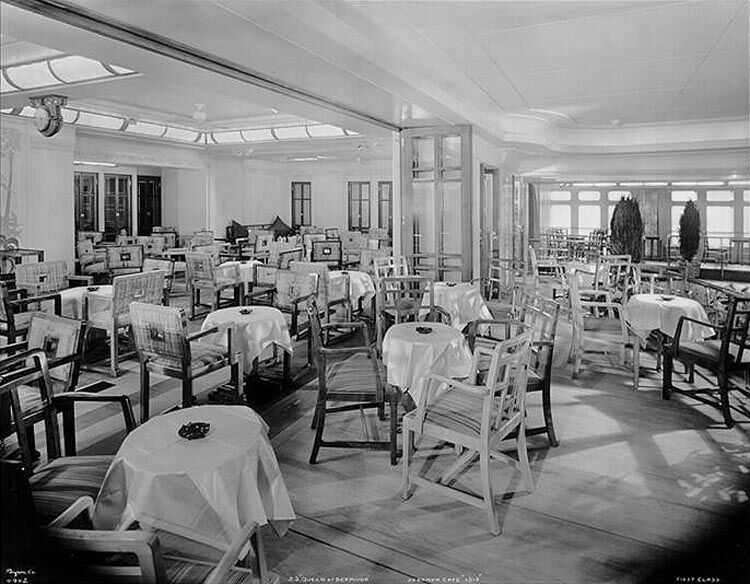
“
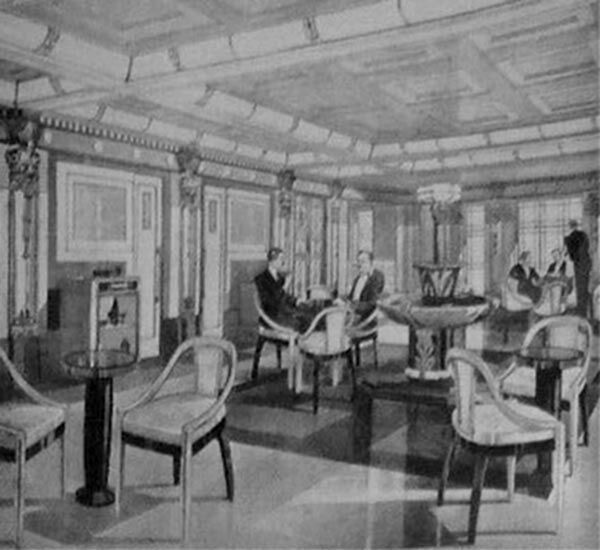
And this is the
“
but was out of sight in the photograph above being out of shot to the left
The Silver Lagoon Pool:
Adjoining the dancing paradise and the
‘Isis’ Verandah Cafe was the “Silver Lagoon
Pool,” the ships semi indoor swimming pool, which was
flanked by a well-equipped gymnasium on the port side, and the
changing rooms being on the starboard side, both having ocean
views. A bulkhead of folding glass screens separated the pool
from the aft sun deck and would frequently be open, as the
weather would mostly be fine.
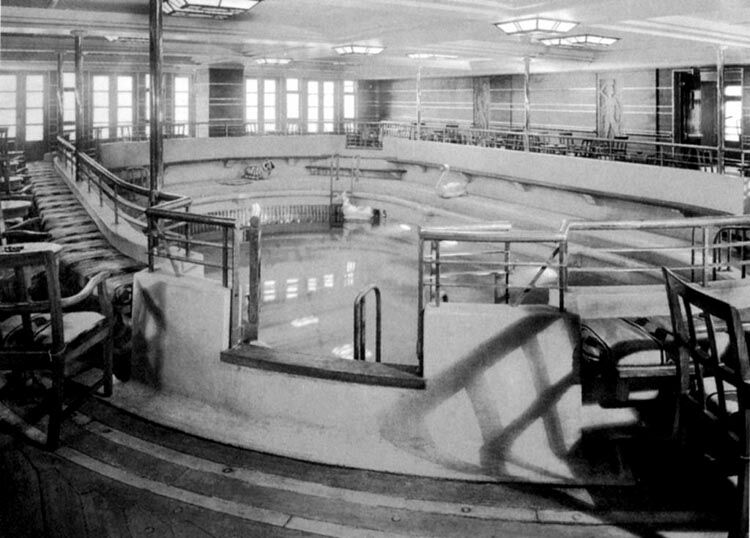
The Magnificent
Silver Lagoon Pool
This deck contained mostly Staterooms, both those that were located outside with a view, and inside ones.
However amidships there were six magnificent Suites, three on each side. Each Suite had a spacious Lounge and a separate Bedroom, as well as a spacious bathroom and a trunk-room. These fine suites were known as the “Marlborough Suites”.
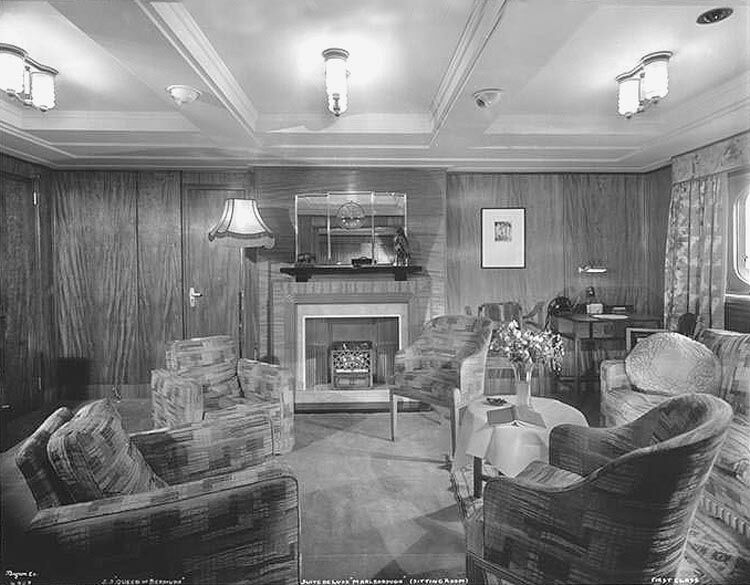
The Suites’
superb Lounge
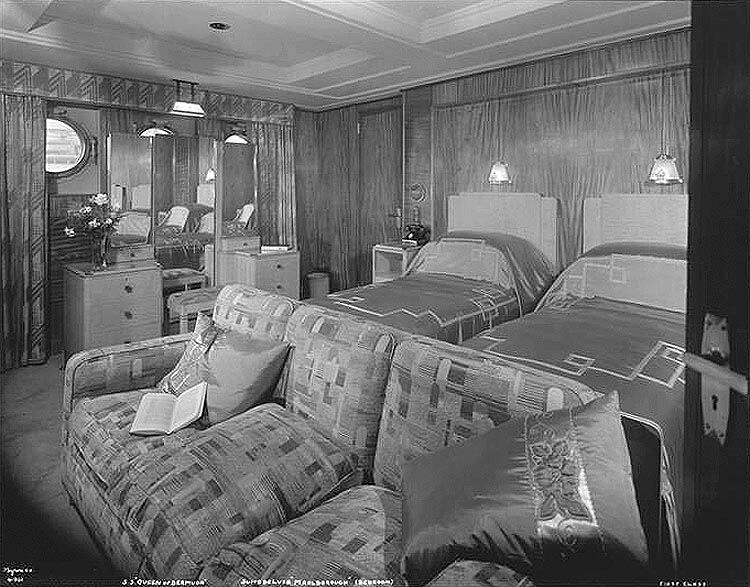
And this was the beautiful spacious bedroom
There were also ten De-Luxe outside Staterooms,
and these Staterooms had additional facilities to the other
Staterooms, although in many ways they were all seemed to be
somewhat similar on the surface.
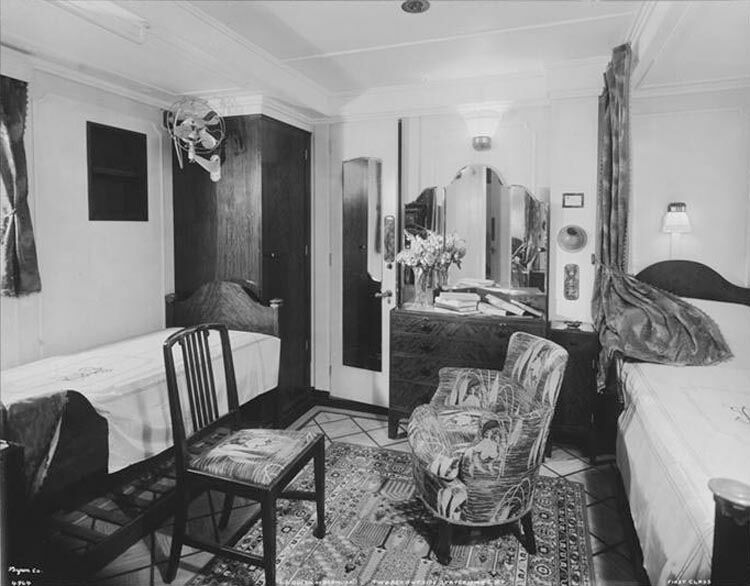
Two bed De-Luxe
Stateroom
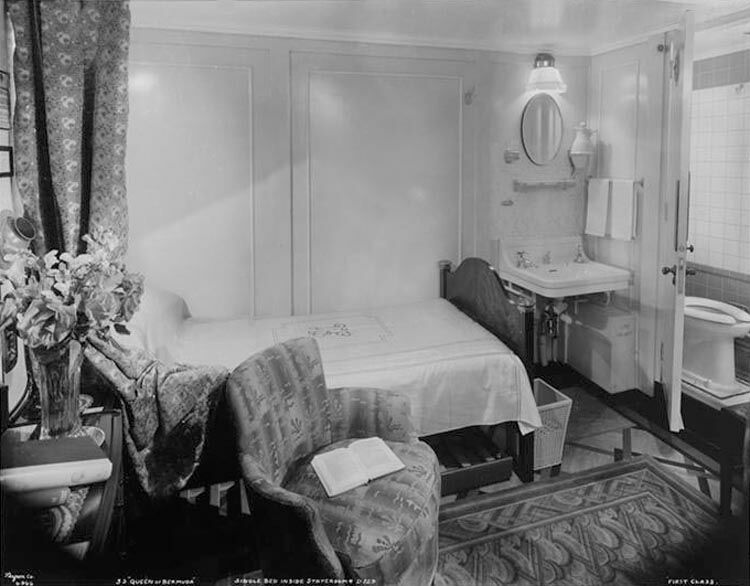
De-Luxe single bed
Stateroom
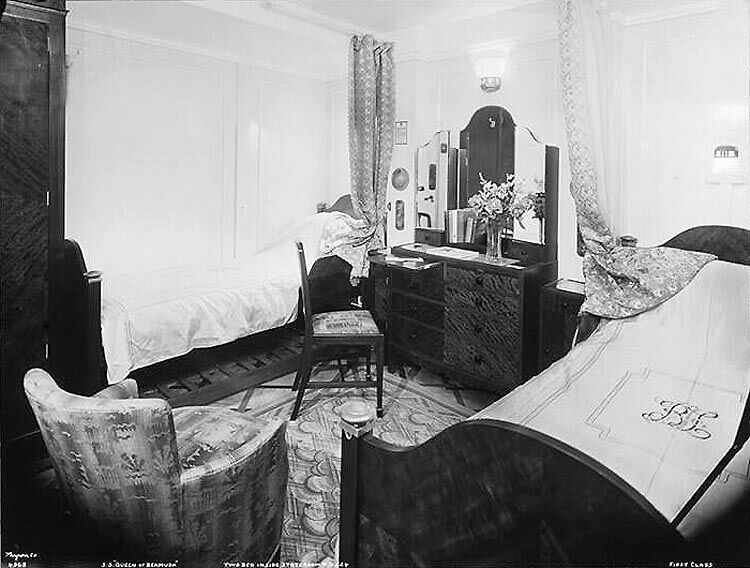
An inside two bed
Stateroom
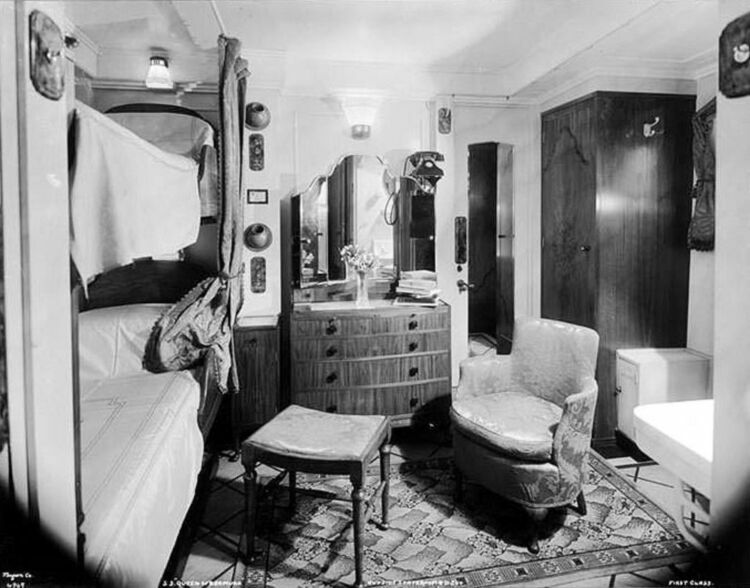
This is a two berth
Stateroom
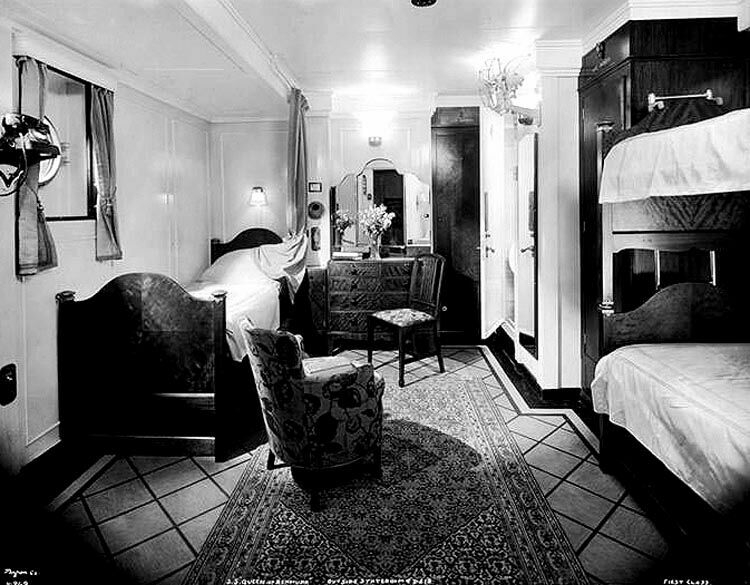
A three berth
Stateroom
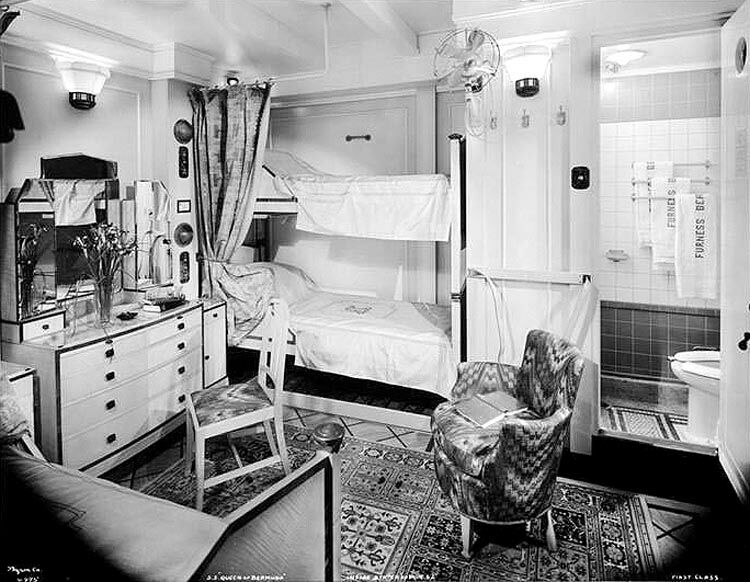
And finally a four berth Stateroom
The above does cover all of the ships First Class accommodations, and from here I will cover the rest of her Public Facilities.
Amidships was the Central Main Lobby with its two Elevators (Lifts) on the two sides, and this venue as we learned earlier, had a view up to Sun and down to E Deck. There was ample seating in the Lobby and in the middle aft was the Ladies Beauty Salon and the Gents Barber, as well as there being several shops.
Again this was mostly an accommodation Deck, but there were some other interesting venues of note here.
Far forward of the Passenger area was the
rather large full width of the ship Horse Stalls, as horses as
well; as at times cattle could be transported to
Amidships was of course the Main Lobby, but in this cat it was also the Main Entrance Hall. Here was most of the Maitre D’ and the Head Steward’s Office, and centred on the aft wall was the Pursers Office. Further aft was the ships Doctors Surgery and waiting Room as well as the ships Hospital and far aft the ships Laundry.
This deck only has a relatively small number of outside and even less inside Staterooms, but there are two main features, being the Main Lobby with was more like a attractive Lounge, as there was a rather fine Cocktail Bar along the side.
Nubian Cocktail Bar:
The adjacent to the lobby on the starboard side was the “Nubian” Cocktail Bar which was an intimate venue that featured black lacquer bulkheads, with a long stunningly rough timbered bar, and horse being ridden on the walls and other art items, yet it had an atmosphere of calmness yet sublimely beautiful! The Bar itself was fitted against the hull so to say and it was without a doubt the most popular Bat on board, especially before and after meals!
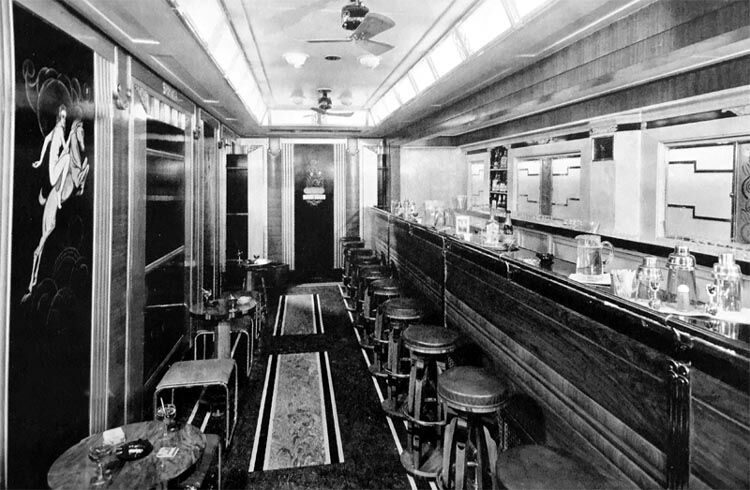
The Nubian Cocktail Bar
Directly aft of the Lobby was the ships stunning Dining room!
Dining Room:
The Dining Room featured light Sycamore walls with jade and silver frieze, the Atrium was done in what was known as ‘Chinese Deco’, with illuminated columns, jade, silver and red lacquer panels with Oriental themes, and there were rich Chinese silk curtains,
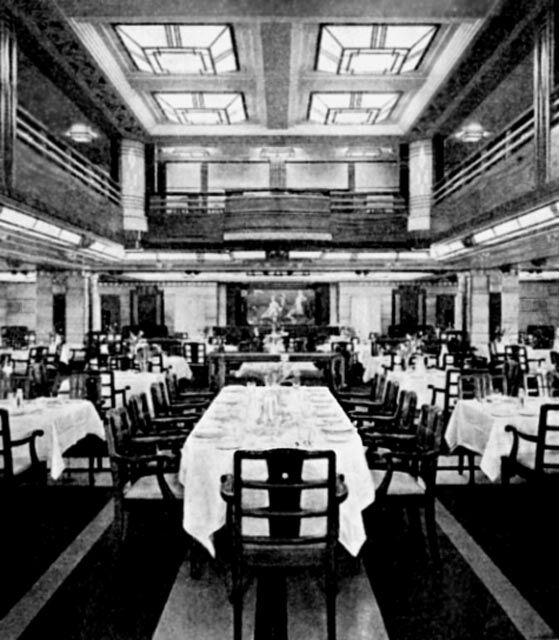
The Dining Room
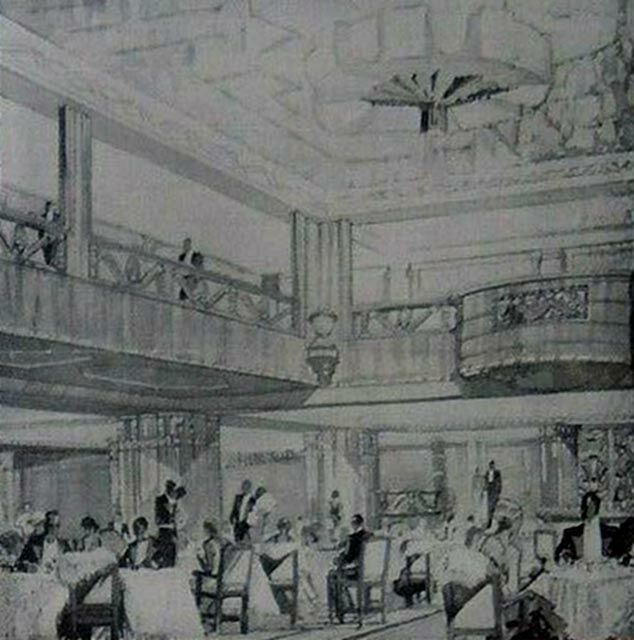
An artist impression of the Dining Room
Again this is the final deck with Staterooms, but the Main Lobby is rather nice and it is the one you would look down to fro the very top of the ship up on Sun Deck right don to here on E deck, were there is a setting of two chairs and a table, a fire place on the forward wall and two curved sofas. Thus a most pleasant place as are all the lobbies!
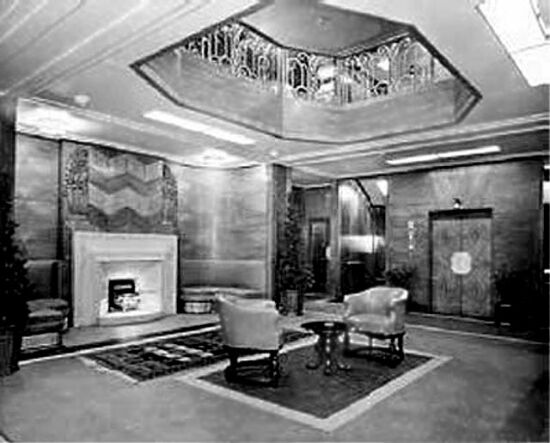
The Main Lobby on E
Deck
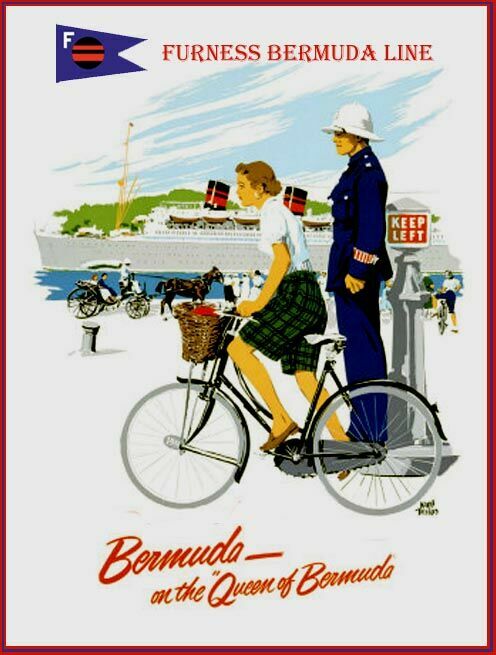
A popular “Furness Bermuda Line” Poster promoting both the “Monarch” and the “Queen of Bermuda”
In regard to Second Class, sadly I have no
photographs whatsoever, but the 31 berthed in this class were
used mainly by passengers who required one-way transportation to
or from Bermuda, rather than the return cruise, with the stay in
As I stated earlier the Cabins here were very similar, although possibly slightly smaller, but they all had private facilities, but with a shower, and not with a bath tub.
There was a Lounge, a Smoke Room aft on C Deck as well as their Promenade Deck and their Dining Room on D Deck, all located aft
********************
Thus the thirties were really wonderful days on
board the “Queen of Bermuda” and nothing could possibly
ruin it, or could it? But as we well know all too soon things
would go terribly go wrong as the world was about to change very
dramatically! It is generally understood that World War 2
commenced on September 1, 1939, beginning with the German
invasion of
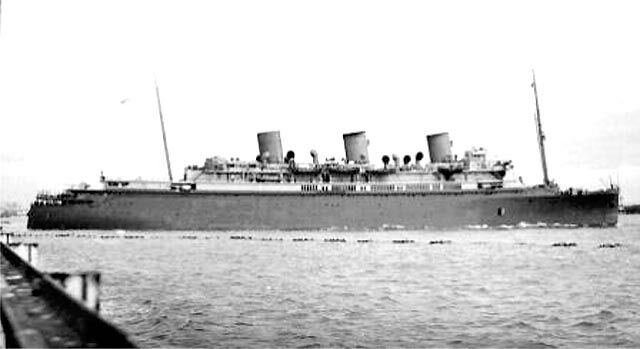
She is seen here
heading to
She departed
Her primary armament was seven BL 152 mm - 6-inch Mk XII Naval guns, and her secondary armament included two QF 76 mm - 3-inch 20 cwt Anti-Aircraft guns. She also carried 2 Fairey Seafox aircraft.
Her conversion was completed on October 28, and
her having worked at her engines, she would now sail at a speed
of 20 knots. On the day of her completion she was also officially
commissioned as the H.M.S. Queen of
First I will list her Commanders from September 2, 1939 to April 1943.
Commander: From: To:
Captain
(retired) Miles Brock Birkett, DSO, RN:
September 2, 1939 - December 6, 1939.
Captain Geoffrey
Alan Brooke Hawkins, DSC, RN:
December 6, 1939 - April 23 1941.
Captain Allan
Thomas George Cumberland Peachey, RN: February
1, 1941 - November 15, 1941.
Commander
(retired) Geoffrey Healey, RN.
November 15, 1941 - December 6, 1941.
A/Captain
(retired) …
the Hon.
Sir Archibald Douglas Cochrane, DSO, RN:
December 6, 1941 - April 1943.
Then from September 1942 to January 1943 she
served with the Eastern Fleet in the
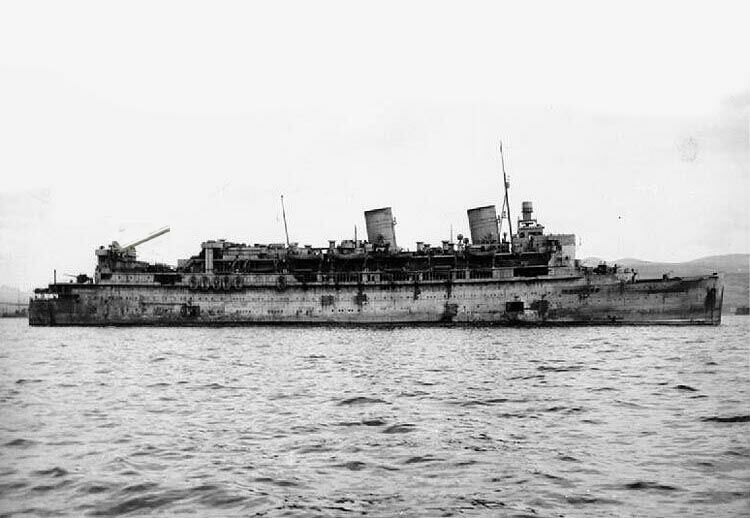
The Armed Merchant
Cruiser “Queen of
at anchor in an
The aircraft were
stored aft topside, where we see the crane facing forward
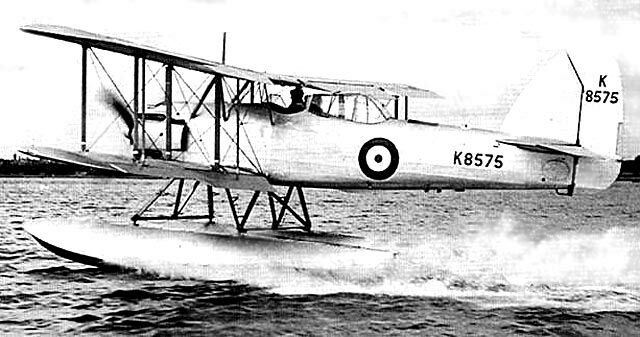
A Fairey Seafox aircraft
Then from January 24, to April 1943 and this
included a visit to Fremantle, the port for the City of
This was a convoy operation conducted during
January and February 1943 to transport the Australian
Army's 9th Division back home from
The AIF began embarking on a number of troop
ships on January 24 1943. The ships assigned to carry the troops
home were the converted ocean
liners ‘Aquitania’, ‘Île de
France’, ‘Nieuw
Amsterdam’ and ‘Queen Mary’. Whilst
the Armed Merchant Cruiser the H.M.S. Queen of
The “Queen Mary” was the first
ship to complete loading, and left ‘Port Tewfik’ on
January 25. She anchored at Massawa three days later, and the
soldiers on board endured very hot conditions until she resumed
her journey. The “
The five ships of the convoy rendezvoused off Perim
on the morning of February 4, and passed
After entering the
A strong escort force was provided the guard
the convoy as it travelled through the eastern
The ships arrived at Fremantle on February
18. “Nieuw Amsterdam” and “Queen of
Bermuda” berthed in
Whilst in the UK she did minor operations in
and around the North sea, but in May 1943 the Admiralty decided
to return her to her owners, ‘Furness, Withy’, but that
was very short lived, for within days the “Ministry of
War Transport” (MoWT) decided to have her refitted, but this
time as a Troop Ship with accommodations for 4,500 troops. For
the next two years she carried troops between
March
29, 1944 sailed the Clyde in escorted convoy KMF30 detached off
Gibraltar for
May
15, 1944 sailed
July
18, 1944 sailed the Clyde in escorted convoy KMF33 carrying
3,601 Gibaltarians from camps in
July
28, 1944 sailed
October
1, 1944 sailed the Clyde in escorted convoy KMF35 carrying
4,029 troops to
November
16, 1944 sailed
December
16, 1944 sailed the Clyde in escorted convoy KMF37 to
November
13, 1945 sailed
November
30, 1945 sailed
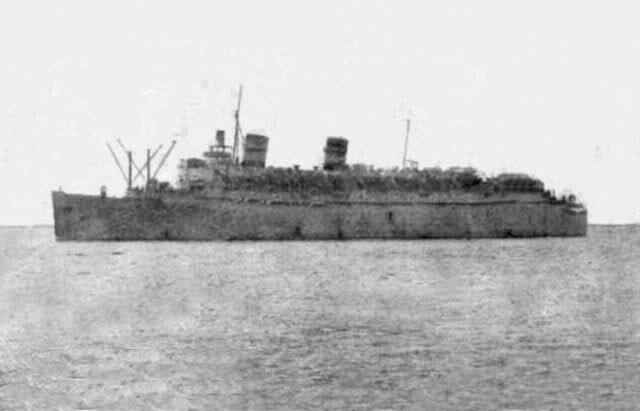
She is seen here as a troop ship around 1944 – 1945
Sorry about the quality of the image, but it is hard to get actual photographs of her as a troop ship
December
9, 1945 sailed
January
9, 1946 Greaser John Lightfoot awarded the British Empire Medal
(Civil Division) in the New Years Honours List and published in
the London Gazette this day.
July
28, 1946 sailed Liverpool for
September
4, 1946 berthed at Liverpool from the
November
10. 1946 sailed
November
15, 1946 passed
December
5, 1946 sailed
December
7, 1946 stood by the
********************
Having arrived home in January 1947 the UK
Government released the “Queen of Bermuda” back to the
“Furness Bermuda Line”, and she could finally return to
her original services. She was sent to the ‘Vickers’
Walker Naval Yard’ on the Tyne where she was given an
extensive overhaul and refit returning her to her being once
again a magnificent luxury passenger ship, as well as restoring
her beloved third funnel.
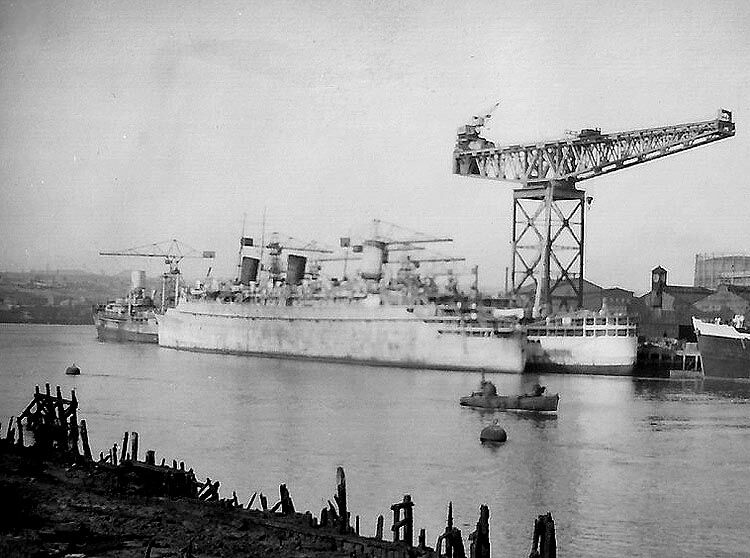
Above &
below: “Queen of Bermuda” seen at the
“Vickers’ Walker Naval Yard” on the
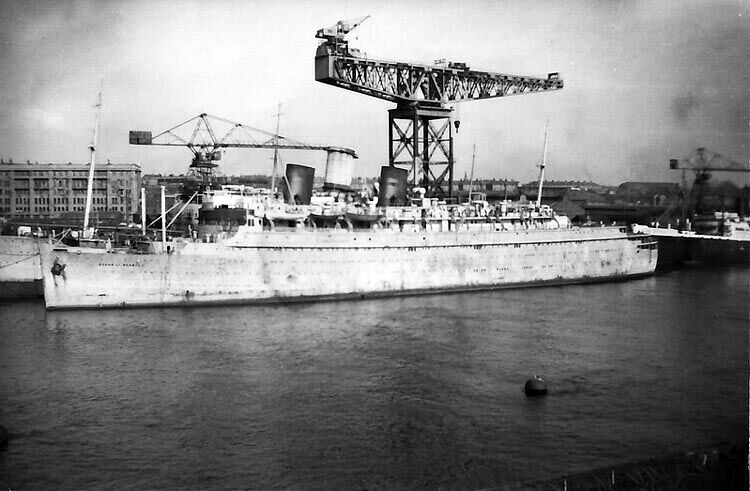
When her refit was completed she now only
offered First Class accommodations for 733 passengers, thus she
was now a 100% First Class luxury Cruise Ship!
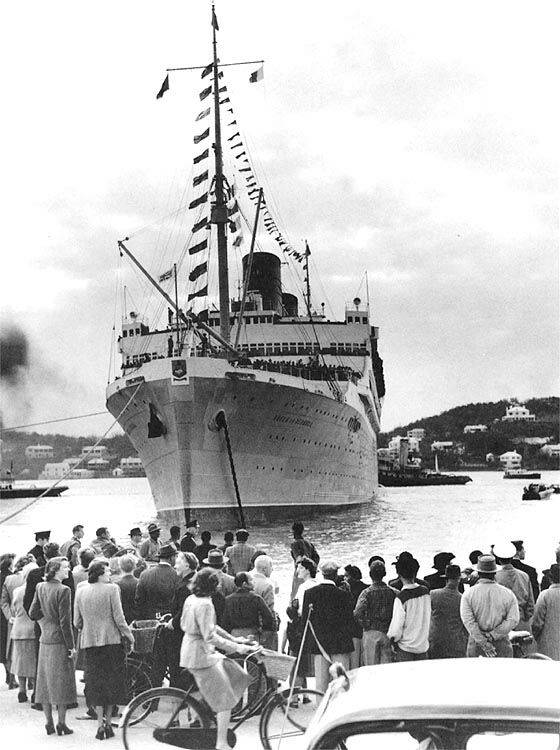
She received a massive welcome HOME from the locals; many shop keepers even closed their doors just
to come dockside and see her arrive and berth and then head beck and do great business once again!
In 1951 a brand new US$15 million “Furness
Bermuda Line” ship arrived on the scene being the S.S. Ocean
Monarch, and she joined Queen of Bermuda on the route
she arrived on her maiden arrival at
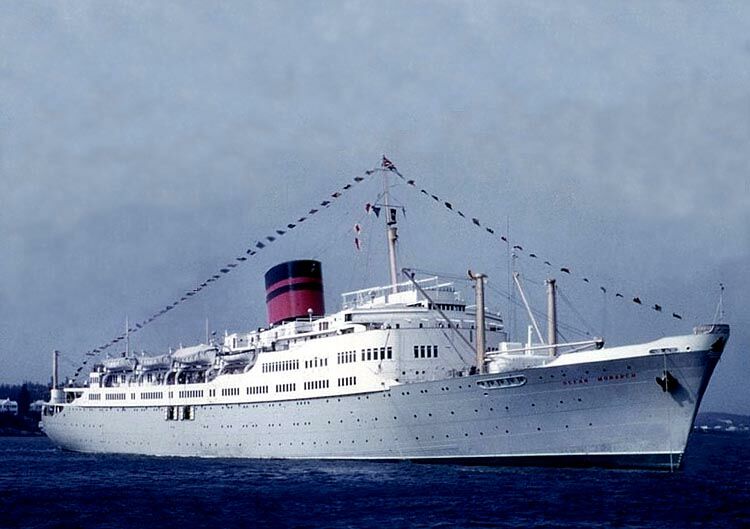
The new 13,834 GRT S.S. Ocean Monarch
But, although the new ship was relatively popular, the great “Queen of Bermuda” somehow remained the No One darling of the fleet as she was sublimely elegant and luxurious!
In the 1950’s the Queen of Bermuda had a
very notable British crew member, and his name was “Tommy
Hicks”, who would later to become the world famous Tommy
Steele, one of
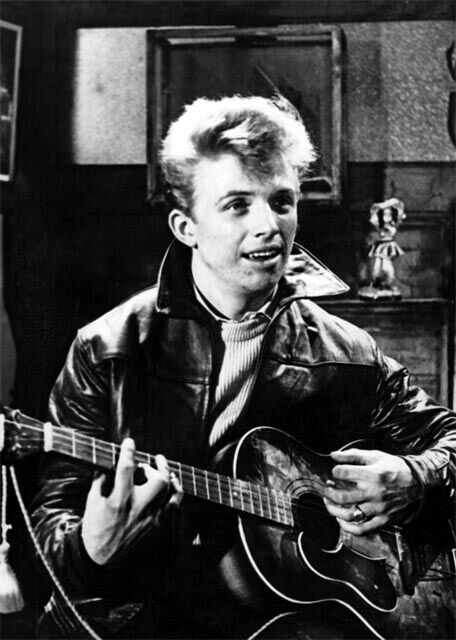
Tommy Steele seen
in the 1950’s
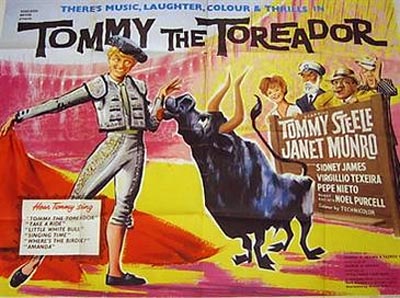
Above &
below: Two of his famous Musical Movies

Tommy first job on board was to man the lift from 9 am until 6 pm, but that did not mean he could go and have a rest, or go and do his own thing, no way, for then he could go and have a rapid meal in the crews quarters and then he had to go and assist with horse the racing or bingo in the Main Lounge until 1 am, only then could he relax.
He loved talking to people when working on the
elevators where his Cockney accent had such an effect on the
mostly American guests and “they would open up like the
But a little later, back home in the
Tommy was born on December 17, 1936, and it was
in 1979 he received an O.B.E., an “Officer of the Order of
the
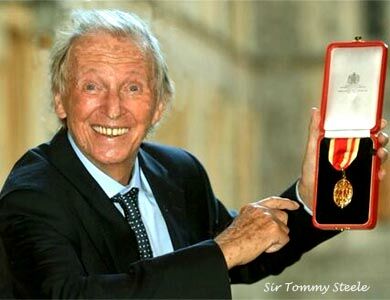
Sir Tommy Steele
was knighted in 2020 aged 83 years of age.
********************
The “Beautiful Queen” as many began
to call her, sailed on and in 1958 her final Captain boarded her,
being Captain Magnus Musson, who remained with her (except for
his vacations) until her final voyage in 1966.
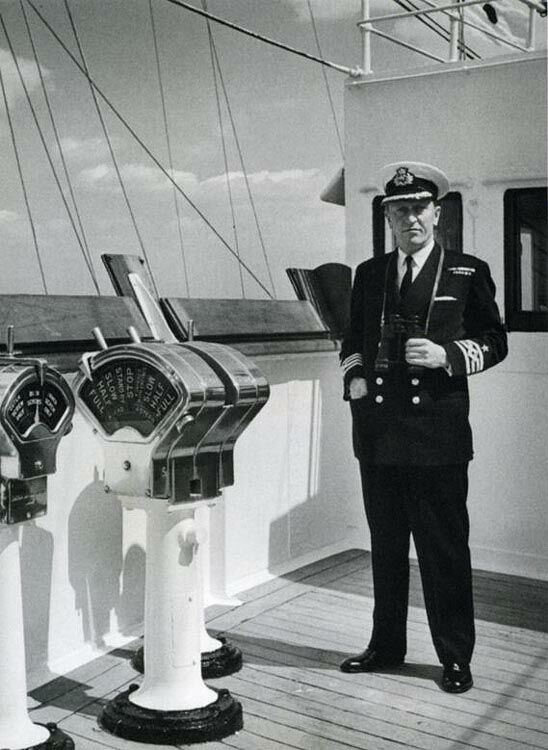
Captain Musson became the “Queen of Bermuda’s” last permanent Captain
In October 1961 she was sent
to ‘Harland and Wolff’ in
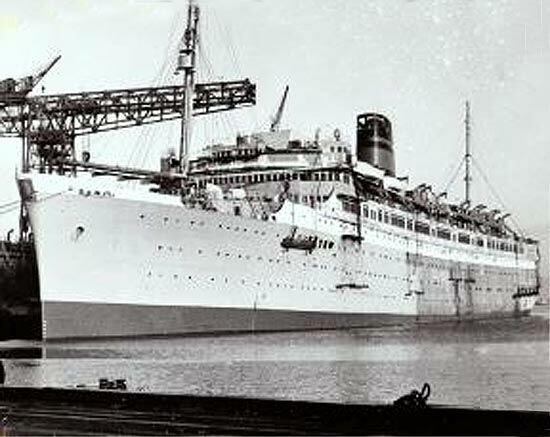
The “Queen of Bermuda” is seen at the ‘Harland & Wolffe’ yard, under going her massive refit in 1961-62
When she was completed she was registered as being 22,552 GRT, and she headed off for her sea trials on February 23, 1962, after which she returned to her regular service on April 7, 1962.
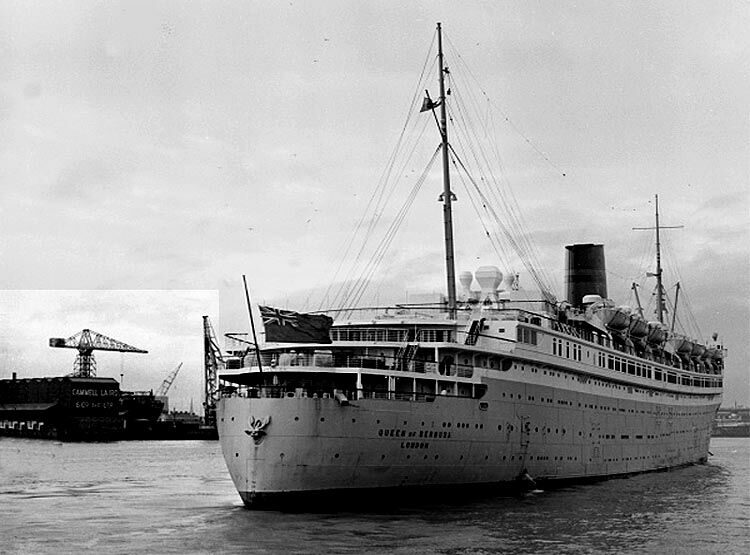
She is seen
departing Liverpool returning to
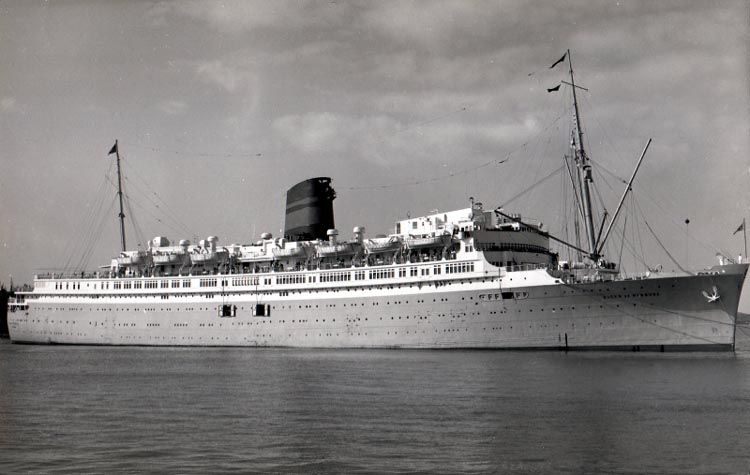
Above &
below: Several photographs of the new look “Queen of
Bermuda”

Her followers still loved her and they continued to sail on her, but the truth is that slowly the time came about that the heyday for “Furness Bermuda Line” was slowly declining with air travel gaining more and more favour, and even the wealthy would fly First Class and be there in just a few hours, and enter in their Five Star luxury hotels!
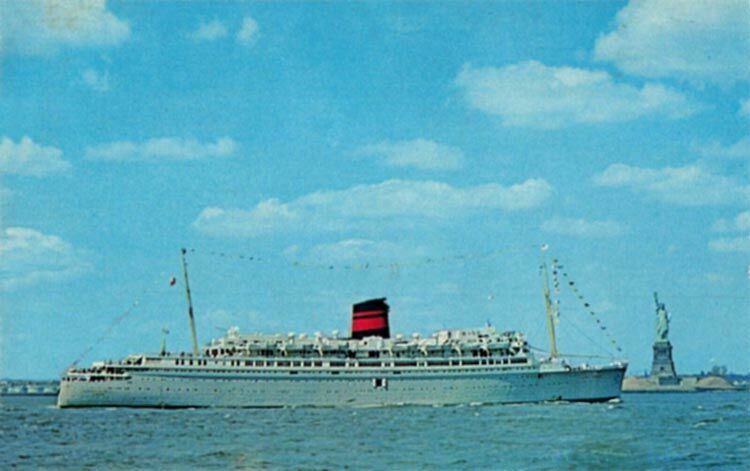
Q.T.E.V. Queen of
Bermuda is seen departing
Thus she was sailing her last few years and her passengers numbers were slowly declining, although still reasonable, but by mid 1966 it was getting to the point decisions needed to be made.
Thus she was sailing her last few years and her passengers numbers were slowly declining, although still reasonable, but by mid 1966 it was getting to the point decisions needed to be made. After deliberations, it was decided by ‘Furness, Withy’ that officially it would be late in November they would end their Bermuda service and they decided to place her on the market, and she was soon sold to new owners for further passenger service, with delivery in December 1966..
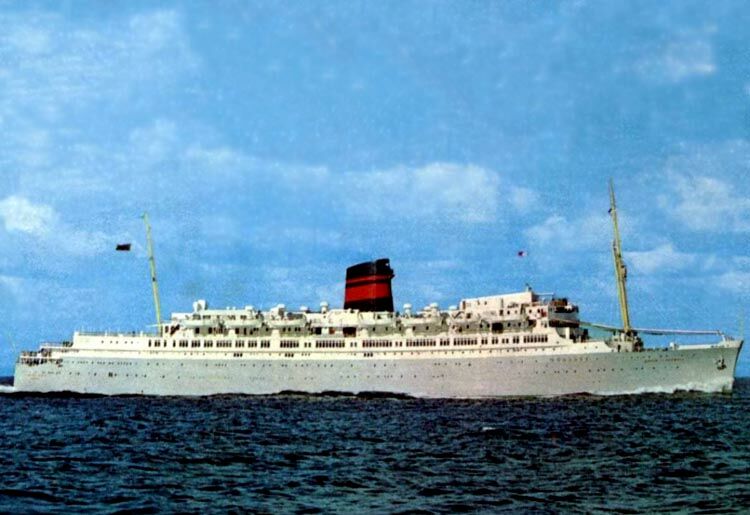
She is seen here
heading for
Whilst the “Queen” was in
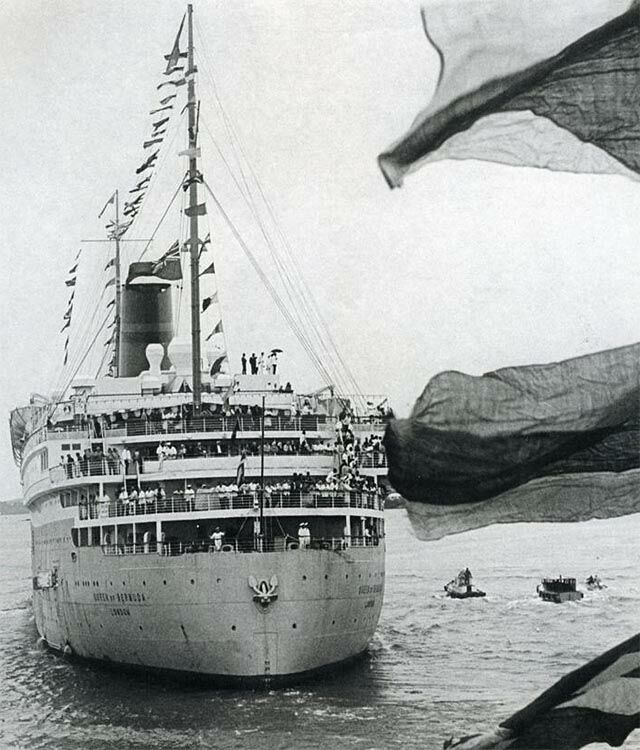
The Great and
magnificent Q.T.E.V. Queen of
from
However, her new owner resold her and the
beautiful “Queen of Bermuda” was sold instead
to be broken up. On December 6, 1966, she arrived
in Faslane in
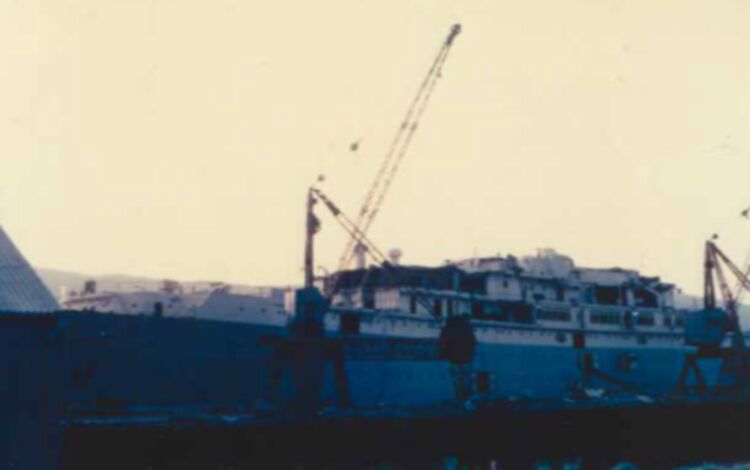
The once great
“Queen of Bermuda” is seen looking very sad indeed at
the Scottish breakers yard
*********************
Name:
Queen of
Owner: Furness, Withy & Co Ltd.
Operator:
Furness
.
Royal Navy - 1939 to 1943.
Route:
Built by:
Vickers Armstrong Ltd, at
Laid Down: December 15, 1931.
Yard No: 681.
Launched: September 1, 1932.
Sea Trials: February 1, 1933.
Delivered: February 14, 1933.
Inaugural voyage:
February 21, 1933, Liverpool to
Arrived
Maiden voyage:
March 7, 1933,
Call Sign: VQJP.
Pennant number: Pennant number F73 - 1939 to 1943.
Tonnage: 22,575 GRT, 12,777 NRT.
Length: 553.47 ft – 168. 7 m.
Beam: 76.7 ft – 23.4 m.
Draught: 26.9 ft - 8.2 m.
Installed Power: 4,274 NHP.
Propulsion & Engines: Fraser & Chalmers, Erith (turbines) & General Electric Co Ltd, Birmingham (motors) - 2 x Steam turbines plus electric motors.
Propellers: Quadruple screws, 200,000 SHP.
Speed: 19 knots service speed, 21,07 knots maximum speed.
Accommodations: 700 First Class & 31 Second Class passengers – 1933 to 1939.
. 733 all First Class - 1949 to 1961.
Crew: 410.
Sensors & Processing Systems: Direction finding equipment, Echo sounding equipment, Gyrocompass, Submarine signalling equipment.
Armament: 7 × BL 6-inch Mk XII naval guns.
. 2 × QF 3-inch 20 cwt anti-aircraft guns.
Fate:
She arrived at Faslane in
Sister Ship:
“Monarch of
View an 11 minute youtube
Video Q.T.E.V.
Queen of Bermuda
Also Visit …
RMS Monarch of Bermuda … From 1931 to 1949, when she was to become the S.S. Australia. In 1958 she was sold to the Greek Line and renamed S.S. Arkadia and she sailed on until 1966.
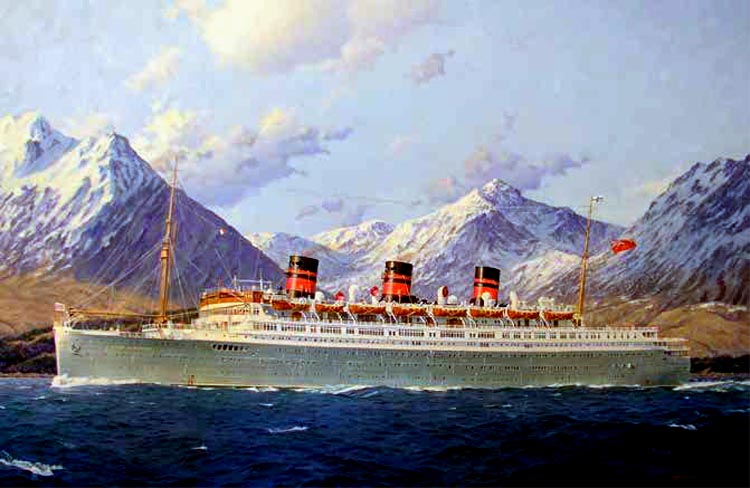
An excellent
painting of the Q.T.E.V. Queen of
This painting is obviously by a great marine artist, but he is sadly unknown thank you Jonathon Malloy for sending it
Is it possibly by
the great Stephen J. Card, but is does not seem to be signed and
his work always is!
*********************
“Blue Water Liners sailing to the
distant shores.
I watched them come, I watched them go and I watched them die.”
Featuring over 1,435 Classic Passenger Liners, Passenger-Cargo Liners & Classic Cruise Ships!
Or ENTER HERE
For interest: Sadly an email service to ssMaritime is no longer available, due to the author’s old age and chronic illness as well as being disabled, etc. In the past ssMaritime received well over 120 emails per day, but Mr. Goossens can no longer handle same. He sincerely regrets this!
*********************
ssMaritime.com & ssMaritime.net
Where the ships of the past make history & the 1914 built M.S. Doulos Story.
The Author has been in Passenger Shipping & the Cruise Industry for well over 60 years
In addition he was
the founder of “Save the Classic Liners Campaign” in
1990.
Please Note: ssmaritime and associated sites are 100% non-commercial and the author seeks no funding or favours of any shape or form, never have and never will!
Photographs on ssmaritime and associate pages are by; the author or from the author’s private collection. In addition there are some images that have been provided by Shipping Companies and private photographers or collectors. Credit is given to all contributors. However, there are some photographs provided to me without details regarding the photographer/owner concerned.
This notice covers all pages; although, and I have done my best to ensure that all photographs are duly credited and that this notice is displaced on each page, that is, when a page is updated!
ssMaritime is owned & ©
Copyright by Reuben Goossens - All Rights Reserved